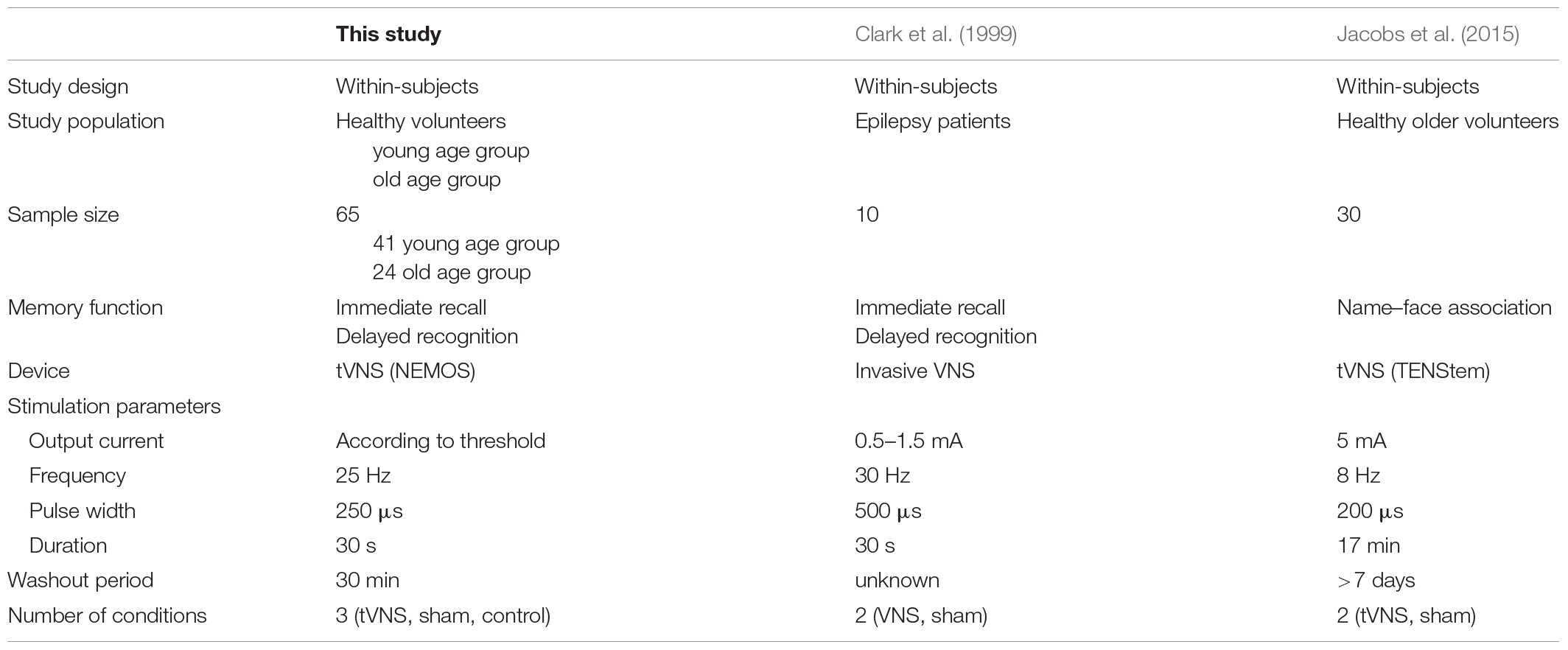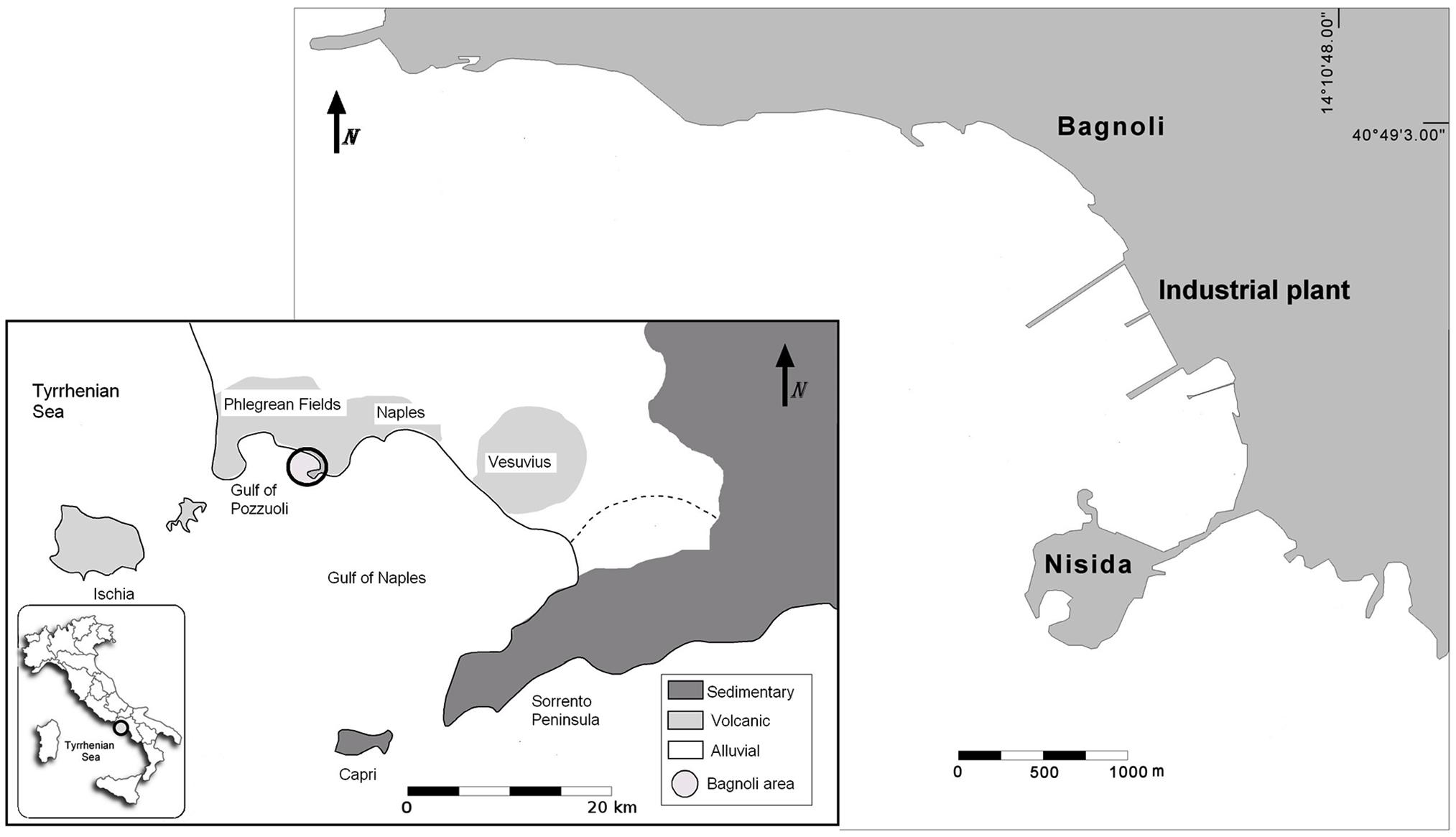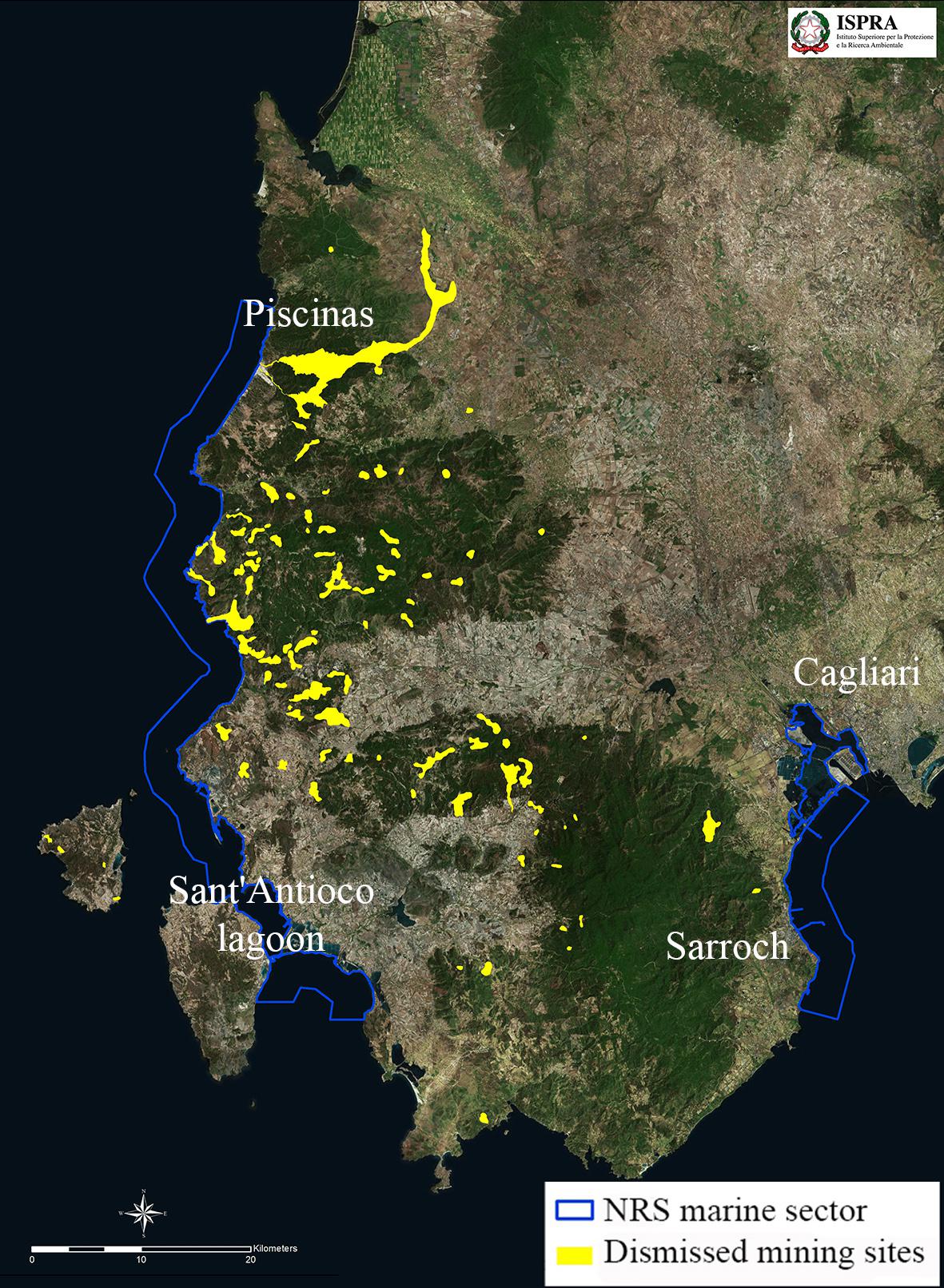- Institute for Environmental Protection and Research (ISPRA), Rome, Italy
In the first decades of 2000s, several Italian sites affected by strong anthropogenic impact were recognized as Sites of National Interest (SINs) for a successive reclamation project, some of which also including marine sectors. These coastal areas are characterized by high complexity and diversity as regards the natural setting as well as for extent, history, type, and degree of contamination. For this, the Italian Ministry of Environment charged its scientific research Institute (earlier ICRAM, now ISPRA) with planning a flexible, adaptable, and large-scale environmental characterization. In this context, the investigation of marine sediments was identified as the primary target to assess the environmental status, because of their conservative capacity with respect to contaminants and their role in the exchange processes with other environmental matrices, such as water column and aquatic organisms. A multidisciplinary, chemical–physical, and ecotoxicological survey was identified as the most appropriate and objective criterion for assessing the sediment quality associated, when necessary, with integrative studies. The results derived from this multidisciplinary approach highlighted the main sources of contamination, together with size and extent of the environmental impact on the coastal marine areas, strictly correlated with the kind of anthropogenic activities and coastal morphology. In order to underline how the different environmental setting influences the degree of anthropogenic impact, four different case studies, selected among the more complex by geochemical and geomorphological viewpoints and more extensively studied, were considered. A comprehensive evaluation of these case studies allowed to deduce some general principles concerning the effects of anthropogenic impact, which can be applicable to other transitional and marine coastal areas.
Introduction
In the last century, part of the Italian territory has been subjected to a strong impact due to the increasing presence of several industrial, mining, and agricultural activities, which gradually determined its environmental decay. Consequently, the Italian Government adopted a national program (D.M. 471/99), similar to that defined by the U.S. Government “Comprehensive Environmental Response, Compensation and Liability Act” (National Research Council 2007), to protect human health and terrestrial and marine environment from hazardous substances released in the most impacted areas. This program, based on several environmental criteria (i.e., site characteristics, quantity, and hazard of pollutants), identified many contaminated areas (d.lgs. 22/97; d.lgs. 152/2006), which required cleanup actions, that were defined as Sites of National Interest (SINs). They were initially 57, 26 of which included marine or transitional areas; successively, the overall number was gradually reduced to 39 in response to improvements in environmental characterization or change of the managing administration (Regional Relevance Site, D.M. 11 January 2013); among the sites including marine areas, the declassed ones were as follows: Basso Bacino del Fiume Chienti, Fiume Saline Alento, Grado e Marano, Litorale Domizio Flegreo, La Maddalena, Litorale Vesuviano, Massa Carrara, Pitelli, and Venezia. At the moment, only 17 SINs including marine or transitional areas are still active (Figure 1 and Table 1).
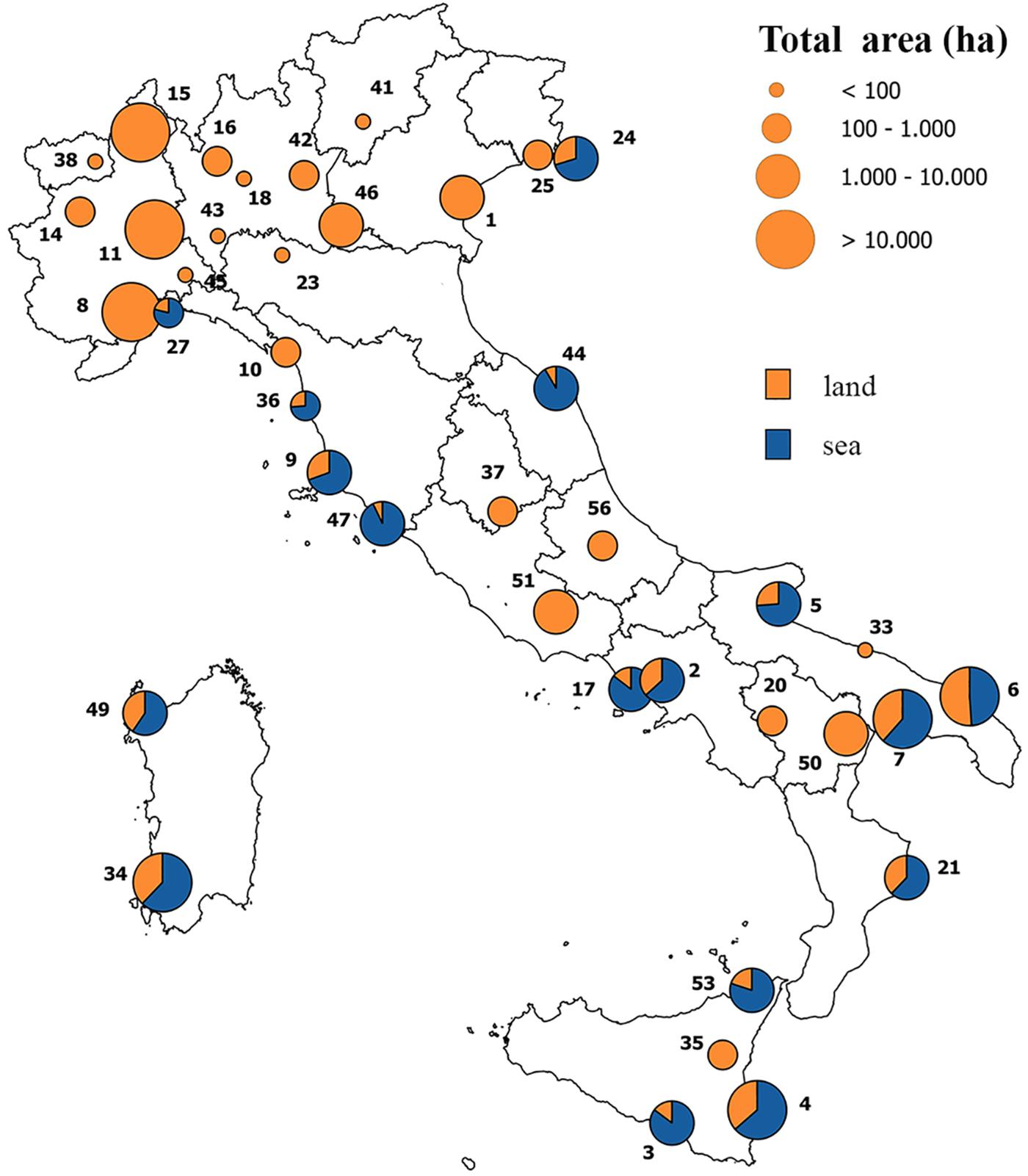
Figure 1. Current Sites of National Interest (SINs) with extent of terrestrial (land) and marine (sea) areas (from ISPRA, 2019, modified). Legend is reported just for sites including marine areas: 2, Napoli; 3, Gela; 4, Priolo; 5, Manfredonia; 6, Brindisi; 7, Taranto; 9, Piombino; 17, Bagnoli; 21, Crotone; 24, Trieste; 27, Cogoleto; 34, Sulcis; 36, Livorno; 44, Falconara Marittima; 47, Orbetello; 49, Porto Torres; and 53, Milazzo.
The marine areas included in the SINs are representative of sandy and rocky coast lines, lagoons, harbors, and river mouths. They are all subjected to a combination of impacts derived from industrial activities (i.e., chemical, petrochemical, metallurgical, steel, mechanical, pharmaceutical, cement, thermal, or thermoelectric plants), incinerators, uncontrolled landfills, intensive agricultural activities, military arsenals, shipyards, and high maritime traffic, which altered the natural conditions. In some cases, the high naturalistic, economic, and touristic values of the area coexist with the anthropogenic activities (Lenzi et al., 2005; Frontalini et al., 2009; Cardellicchio et al., 2015; Romano et al., 2015, 2016, 2018b; Cannata et al., 2016). The supply of contaminants to the aquatic environment may occur for direct discharge to the sea, contribution of runoff from contaminated lands, atmospheric deposition, and so on. In this context, marine and transitional sediments play a fundamental role, as they are the final sink of most of the toxic, persistent, and bioaccumulative (Kowalewska et al., 2011). In most cases, although the supply of contaminants ceased owing to the closure of the plants or the implementation of environmental legislation and accompanying treatment technologies, the contamination persists as a legacy (Croudace et al., 2015). In other cases, the supply is still active for both the continuation of polluting activities and the presence of waste materials as secondary source, for example, in dismissed mining sites where large of mine residues are still subjected to processes of weathering (Romano et al., 2017).
The main contaminants are metals and trace elements, heavy hydrocarbons, polycyclic aromatic hydrocarbons (PAHs), polychlorobiphenyls (PCBs), organochlorine pesticides, dioxins and furans, chlorinated organic solvents, and organotin compounds (TBTs). Most of them, owing to their hazardous and/or persistent characteristics, belong to the priority list of the European Water Framework Directive (2000/60/EC); in fact, they were demonstrated to be a threat for the aquatic environment, having adverse effects on organisms and also bioaccumulating in their organs and tissues, so representing a potential risk for human health (Suedel et al., 1994; Atkinson et al., 2007).
In addition to the chemical contamination, some sites underwent also physical changes, like as strong modification of the coastline due to the construction of industrial and harbor facilities, which influenced water circulation, sediment transport, and deposition as well as contaminant distribution (Romano et al., 2009a).
In order to establish an adequate investigation strategy for the marine coastal areas, not yet provided for by Italian legislation, in 2001, the Ministry of Environment (MoE) tasked its scientific research institute (earlier ICRAM, now ISPRA) with designing a flexible and large-scale monitoring program aimed at obtaining an integrated assessment of environmental quality, taking into account extension, history, type, and degree of contamination, and also natural features such as morphology, geology, geochemistry, and hydrodynamics.
This review presents the methodological approach used to characterize these areas and the obtained results. It then explains how this approach was successfully applied to elucidate the different responses to the anthropogenic impact as a function of geological/geomorphological setting and hydrodynamic conditions. A special focus was committed to four case studies because of their complex environmental scenario and long-lasting anthropogenic impact, in order to deduce criteria of general interest concerning the effects of anthropogenic impact in transitional and marine coastal areas and the approach to be adapted according to specific conditions.
Investigation Approach
The investigation strategy was planned taking into account the main European legislations on the environmental topics in force at that time, as Water Framework Directive (2000/60/EC), Barcelona (1976), OSPAR (1992), and HELCOM (1992) Conventions. The environmental assessment consisted on summarizing the distribution of contaminants in the marine areas, taking into account all the environmental matrices (sediments, water, and biota) and identifying the potential risk for the aquatic environment and/or human health in relation to their uses (fish life, fishing, aquaculture, bathing, recreational uses, etc.). Among the three matrices, priority was given to the study of sediments because they represent the final sink of most anthropogenic contaminants and are considered the most conservative matrix playing a primary role in the accumulation of contaminants through various types of processes, from the simple deposition of suspended particles to adsorption by clay minerals, as well as in their redistribution, through biotic and abiotic exchange processes at the interface with water column (Li et al., 2000; Santschi et al., 2001; Spencer and Macleod, 2002). Water and biota were considered in a second phase of the investigation owing to the highly dynamic and variable property of the water column and the different responses of the biota that can vary significantly according to seasonal variations, type of contamination and species, gender, tissue, size, and reproductive status considered (Birch, 2017).
A regular and systematic sampling strategy for the sediment characterization, according to the same principle used for geochemical mapping (Reimann et al., 2010, 2015), adaptable to the features (type and extension of the study area) and environmental settings (i.e., industrial plants), was adopted (Figure 2). The sampling scheme was organized in grids of variable size (from 50 × 50 m to 450 × 450 m), according to the complexity of the site, and transects to cover the remaining areas. A sediment core (from 2 up to 5 m, according to the distance from the contamination source) in each grid and a variable number of superficial samples on the transects were planned (Figure 2).
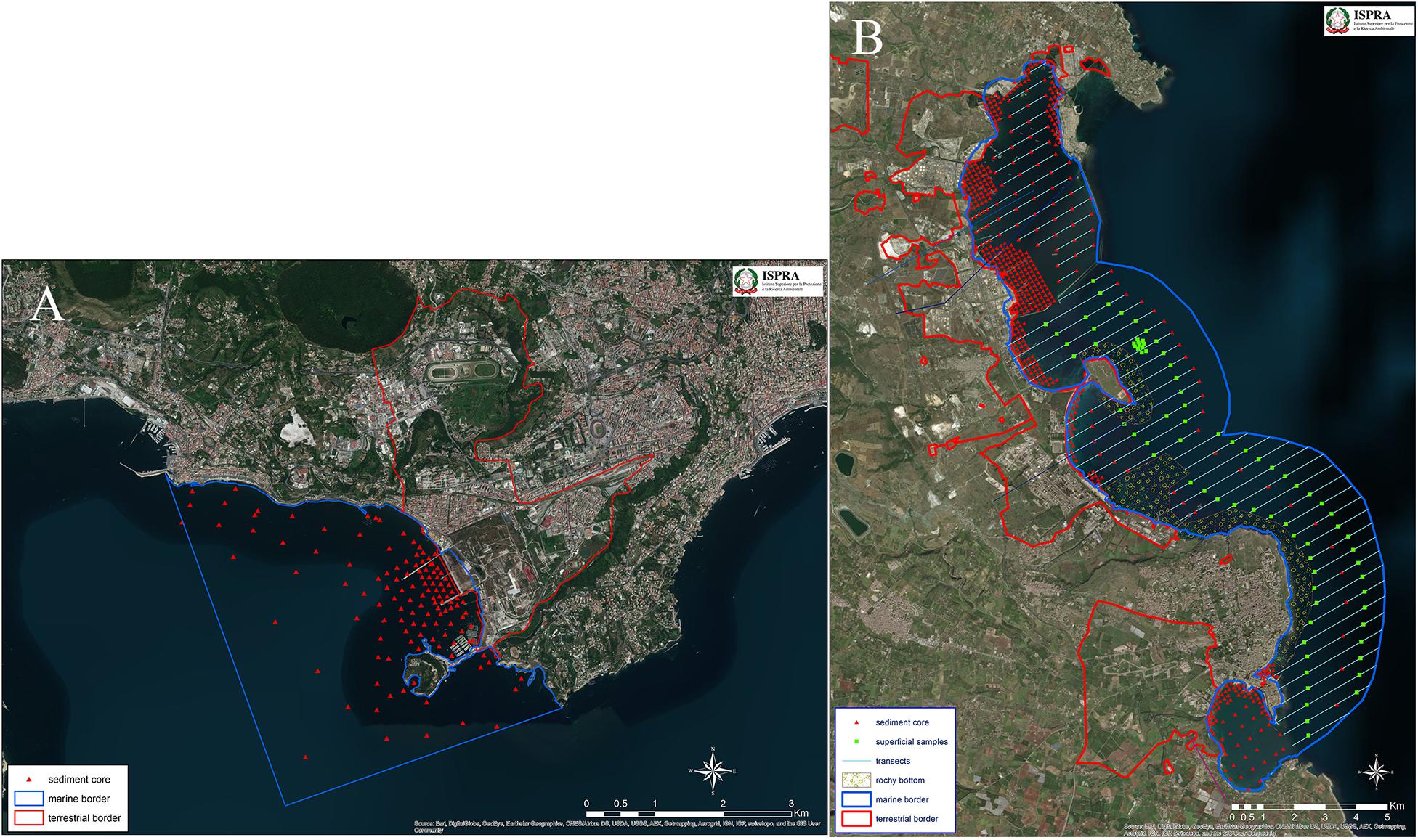
Figure 2. Examples of sediment sampling srategy. Sites of National Interest (SINs) Bagnoli (A) and Priolo (B).
Standardized levels (0–10, 10–30, 30–50, 100–120, 180–200, 280–300, 380–400, and 480–500 cm) from sediment cores were defined and finalized to physical, chemical, and ecotoxicological analyses. Also, standard chemical–physical analyses [such as grain size, total organic carbon (TOC), metals and trace elements, PAHs, PCBs, heavy hydrocarbons, and chlorinated pesticides] were planned for all the samples; a number of additional chemical analyses (chloroaromatics, phenols, aromatic solvents, TBTs, dioxins, and furans) were also included in the monitoring scheme, together with ecotoxicological and microbiological analyses, provided that they were directly connected to the known industrial activities in each area.
In geochemically anomalous areas, where high metal and trace element concentrations can be naturally enriched in the sediments, it was considered necessary to discriminate the geogenic contribution from the anthropogenic one (Xu et al., 2014; Romano et al., 2015, 2018a; Guo and Yang, 2016; Birch, 2017, among the most recent ones). For this purpose, some sediment cores, sampled at high resolution (2 cm levels) and representative of the whole site, were used for reconstructing the evolution of contamination and determining the local background values (BGVs) (Matschullat et al., 2000; Apitz et al., 2009; Romano et al., 2015, 2018a).
In order to highlight the bioavailability of contaminants and assess the potential risk of contamination in the aquatic environment, specific bioaccumulation (Ausili et al., 2008; Signa et al., 2017), and biomarker (Losso et al., 2004; Annicchiarico et al., 2007) investigations on marine organisms, such as bivalves and some nekton and benthic species, were included in the investigation plans.
Owing to the lack of reference values for assessing environmental status in anthropized marine coastal areas, with the only exception of the Environmental Quality Standards (EQS) for sediments (D.M. 56/09, D.M. 260/10), as defined by the Italian Government according to 2000/60/CE, but not applicable for impacted areas, ICRAM defined site-specific “action levels” according to the current scientific literature (Burton, 2002; Wenning et al., 2005; den Besten, 2007) and the main approaches already applied by the USA (U. S. Environmental Protection Agency, 1996, 1997), Canada (CCME, 2001; Macfarlane and MacDonald, 2002), and Europe (van de Meent et al., 1990; Ospar Commission, 2004a, b), taking into account the peculiar geochemical characteristics along the Italian coast.
A chemical–physical and ecotoxicological approach was identified as the most appropriate and objective criterion for assessing these values. Specifically, the “effect level approach,” which statistically associates chemical and biological data to define sediment concentration levels with rare toxic effects [threshold effect level (TEL)] and levels above which the effects are frequently encountered [probable effect level (PEL)], was adopted (Long et al., 1995; MacDonald et al., 1996, 2004). After that, action levels were determined by taking into account site-specific chemical and ecotoxicological data for each SIN, according to standardized procedures by national and/or international bodies such as ISO, USEPA, ASTM, and UNI (Table 2).

Table 2. Site-specific action levels for metals and trace elements (mg kg–1 d.w.), as determined by ICRAM.
The analytical data were processed by applying geostatistical methodologies in order to reconstruct the vertical and spatial distribution of contaminants, allowing an easier data managing aimed at the three-dimensional reconstruction of the extent of contaminant concentrations (Innocenti et al., 2005).
Environmental Status of Marine Coastal Areas
Almost all the coastal marine areas included in the SINs were completely characterized between 2004 and 2014. The results highlighted the presence in most sites of high concentrations of contaminants attributable to current or previous human activities, and lower concentrations in the other cases (Gabellini et al., 2011; Ausili et al., 2012). In all sites characterized by industrial and harbor activities, the spectrum of contaminants in the marine environment was fairly homogeneous; in fact, metals and trace elements, PAHs, and heavy hydrocarbons were prevalently and ubiquitously present, although the concentrations varied from site to site depending on the type of activity and the harbor’s vocation (commercial, industrial, military, tourism, etc.). Only two SINs were characterized by a single source of pollution, that is, Cogoleto, where a factory produced Cr compounds for decades, and Manfredonia, where nitrogenous fertilizers were prevalent (Figure 1).
Based on the all results, it was possible to group SINs according to the impacts and types of anthropogenic activities. The ones characterized by long-lasting and past activities of iron and steel plants like as Bagnoli, Piombino, Pitelli, and Crotone, or still active, such as Taranto, were mainly contaminated by metals and trace elements (Cd, Pb, and Zn and, secondly, As, Cu, and Hg), according to the type of processing and raw materials used (Figure 1). The highest concentrations exceeding one or two order of magnitude the action levels for Cd, Hg, Pb, and Zn were recorded on the sea bottom closest to the plants. The concentrations showed a very wide range, generally decreasing from coast to offshore (Figure 3), and with the highest values in the superficial sediments (up to 1–1.5 m), even if in some sites like Taranto, Piombino, and Bagnoli the contamination attained a depth of 3–3.5 m, ascribable to the past maximum industrial activities and/or the absence of adequate environmental legislation (Table 3). In the same sites, also high concentrations of PAHs (>1,000 mg kg–1), benzo(a)pyrene (>100 mg kg–1), and TBTs (12 mg kg–1) were recorded.
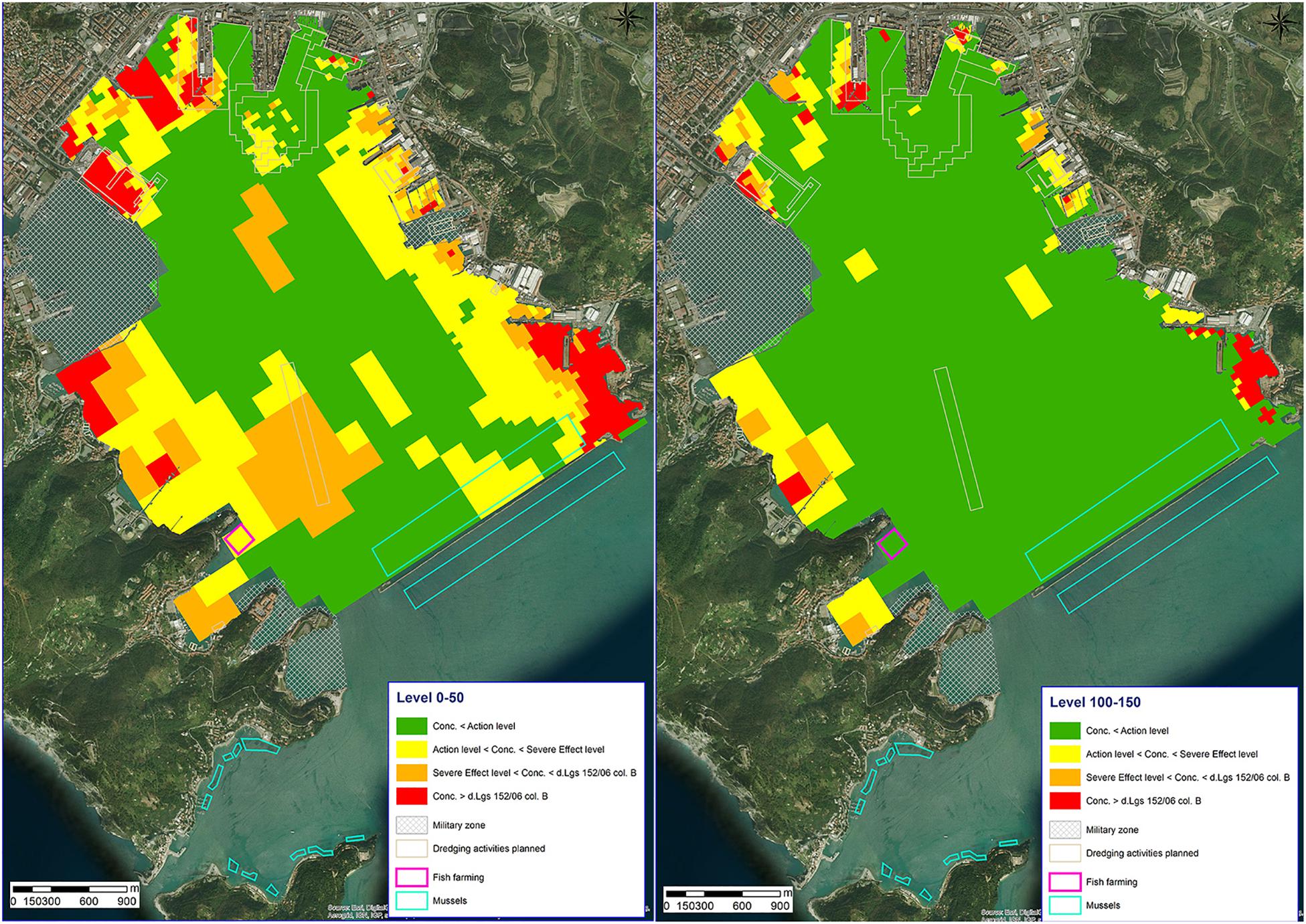
Figure 3. Environmental status of Site of National Interest (SIN) Pitelli at different depths (0–50 and 100–150 cm).
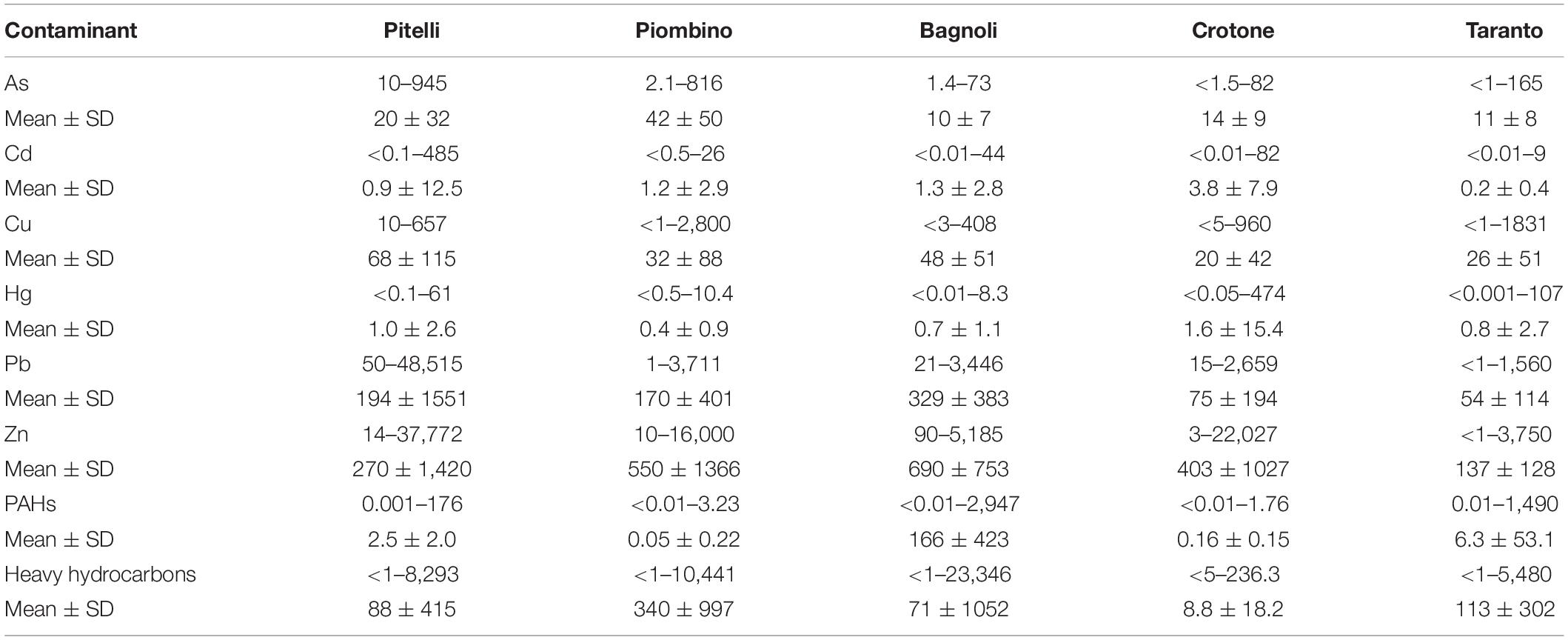
Table 3. Descriptive statistics of contaminant concentrations (mg kg–1 d.w.) in SINs characterized by long activity of large iron and steel plants.
The SINs characterized by both industrial and petrochemical activities (Napoli, Brindisi, Livorno, Priolo, and Gela; Figure 1) showed a contamination mainly due to metals and heavy hydrocarbons (Table 4). In spite of the similar activities, the magnitude and extension of sediment contamination were very different between sites. These differences are well evident between Priolo, in particular the Augusta harbor, and Gela sites, where the concentrations of Cu, Hg, Pb, Zn, PAHs, and heavy hydrocarbons differ by up to three orders of magnitude. This can be due to the location and morphology of the two sites, a natural bay closed by artificial dams, which facilitates the accumulation of contaminants in fine sediments for Augusta harbor, and an open coastal site, subjected to strong coastal currents, for Gela. Similar differences can be noticed in Napoli (Figure 4) and Livorno harbors, where the contaminant distribution is strongly different, diffuse in the first one, and concentrated only close to the piers in the second one, according to the different morphological and harbor settings.
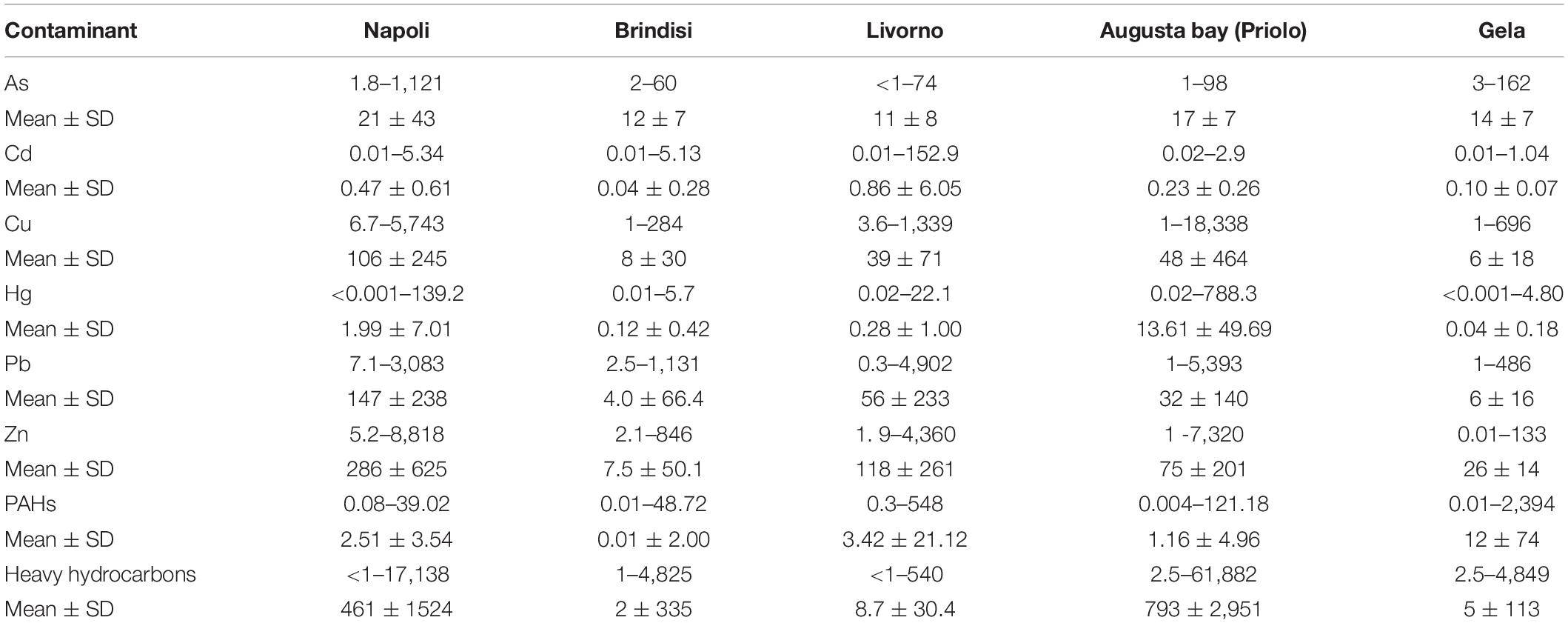
Table 4. Descriptive statistics of contaminant concentrations (mg kg–1 d.w.) in SINs characterized by industrial and petrochemical activities.
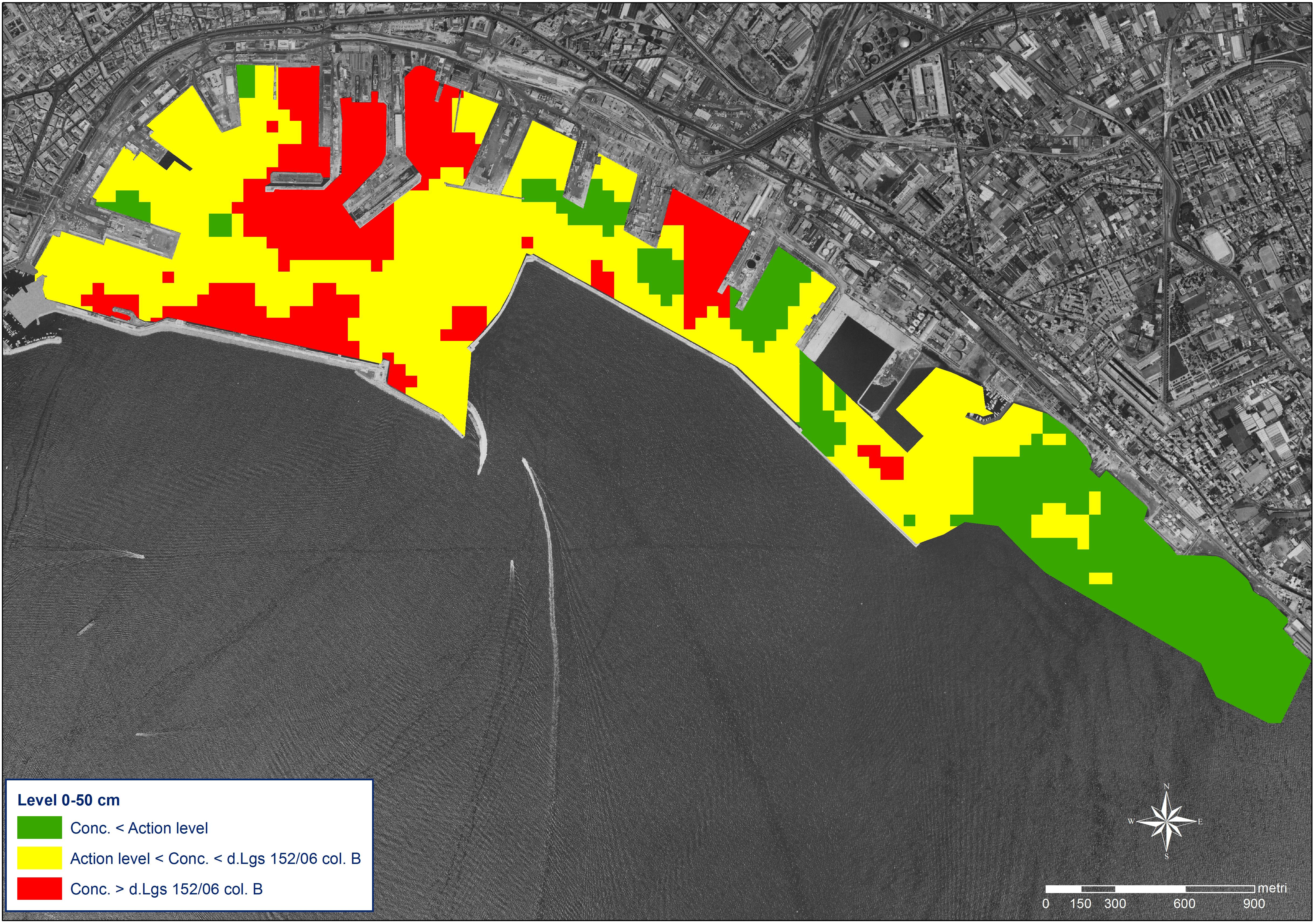
Figure 4. Environmental status of Site of National Interest (SIN) Napoli, with particular focus on the internal harbor.
In the other sites, the contaminants showed always lower concentrations (Litorale Vesuviano, Massa Carrara, and Falconara Marittima) except for two sites, both of them impacted by past mining activity (Orbetello and Sulcis) and also characterized by geochemical enrichment (Hg for Orbetello, Romano et al., 2015; Cd, Pb, and Zn for Sulcis, Romano et al., 2017).
In almost all the investigated sites, the ecotoxicological response showed a toxic effect due to the complex mixtures of contaminants, strictly correlated with the concentration recorded in the sediments; only in a few cases (i.e., Sulcis) was this correspondence not recognized.
The studies carried out on marine organisms generally showed a tendency to bioaccumulate those elements and compounds that had been identified as contaminants of concern by the environmental characterization. In the Napoli, Brindisi, and Taranto SINs, Pb is the metal that most accumulates in the organisms, as evidenced by the increase of concentrations in transplanted mussels (mussel watch) and the higher concentrations recorded in fish species than those of control areas; in particular, the most significant concentrations were recorded in the liver of fishes, testifying current availability of these contaminants, even if the concentrations never exceeded the limit values reported in the annex EC Regulation 1881/2006, which defines the maximum levels of some contaminants in products for human consumption. Only in SIN Taranto were high PCB and PAH concentrations, among which benzo(a)pyrene with higher values, found in the mussels with higher values than those reported in the EC Regulation.
The general results of the environmental characterization highlighted for all the SINs how the degree and extension of contamination were directly correlated with the morpho-bathymetric and sedimentological characteristics, as well as the coastal morphology where the site is positioned (enclosed bay, lagoon, open sea, etc.).
Selected Case Study and Their General Interest
Some SINs, characterized by different environmental settings (lagoon, bay, coastal site) and types of impact (mining, iron and steel plant, and chemical and petrochemical factories), but with common features of geochemical and geomorphological complexity and long-lasting and multi-source contamination, are considered of particular significance and described below. The comprehensive evaluation of results derived from the characterization and the integrative studies was useful for deducing general principles applicable on the environmental characterization of contaminated areas with similar characteristics.
Orbetello (Tuscany)
The SIN Orbetello includes the homonymous lagoon, located close to Monte Argentario (southern Tuscany, Figure 1). It is an enclosed brackish-water coastal basin, divided into West and East sub-basins by a dune cordon, connected with the sea by means of few narrow canals (Nassa, Fibbia, and Ansedonia) and characterized by very shallow water (mean depth 1 m). It was classified as Site of Community Importance (SIC IT51A0026), Special Protection Area (SPA IT51A0026), and protected area under the Ramsar Convention, classifying it as site of high naturalistic value (Figure 5). From a geological viewpoint, it is included in the sector of the southern Tuscany where, starting from Miocene (20 My–5 My ago), the uplift of magmas into carbonate Mesozoic rocks determined widespread mineralization, particularly abundant in the Monte Argentario and, more consistently, in the close Monte Amiata district (Protano et al., 1998; Grassi and Netti, 2000). In the East basin, mining over large scale was carried out from 1873 to 1958 with the exploitation of mainly pyrite (FeS2), chalcopyrite (CuFeS2), and cinnabar (HgS). Industrial activity affected the West basin, owing to a factory (ex-SITOCO) that produced, from 1908 to 1985, granular fertilizers and, as waste products, sulfuric acid and copper sulfate, as well as pyrite-rich ashes in As, Cd, Zn, and Pb. Moreover, the lagoon has been affected by sewage effluents from the Orbetello town, and wastewater from agriculture and aquaculture, which increased considerably in the second half of the 20th century (Lenzi et al., 2003).
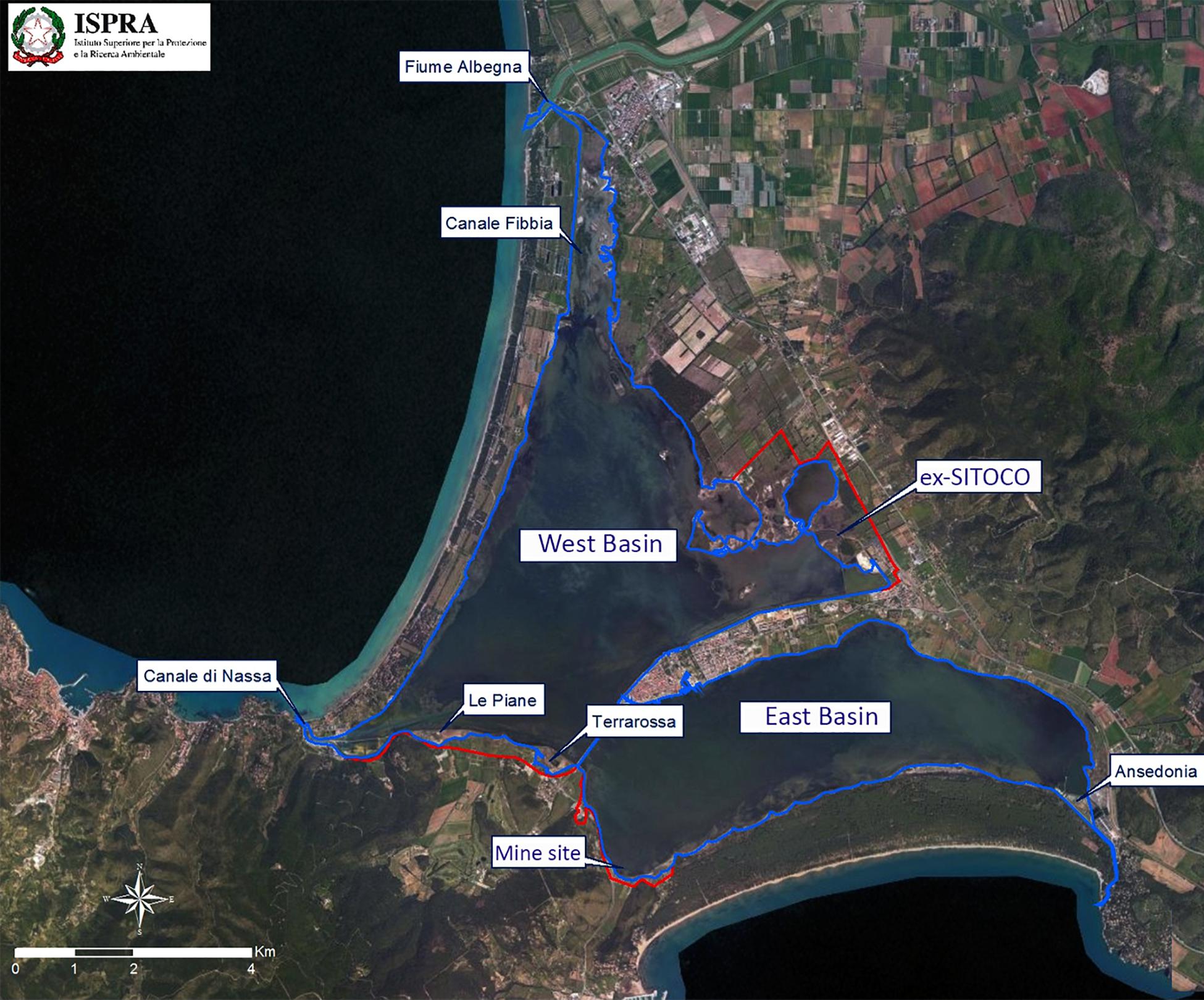
Figure 5. Site of National Interest (SIN) Orbetello. Main anthropogenic activities (ex-SITOCO factory and mine site).
The environmental characterization, which was preceded by preliminary environmental studies, carried out by different bodies (Regional Environmental Protection Agency, ISPRA, University of Siena), involved the collection of both surface samples and sediment cores. Sediments of the lagoon were mostly silty, with considerable percentages of sand, mainly constituted by bioclastic fraction. Chemical analyses indicated considerable enrichment for some trace elements (As, Cd, Cr, Cu, Hg, Pb, and Zn); Hg, in particular, showed very high concentrations (up to 70 mg kg–1), not only in the surface samples but also in depth (ISPRA, 2009b). Concentration levels were the highest in the east lagoon, close to the mine site, indicating the exploiting activities as the main source of contamination. Another sector, characterized by significant contamination, was recognized close to the ex-SITOCO plant, where higher concentrations of some trace elements (As, Cd, Cu, Pb, and Zn) were recorded (ISPRA, 2008, 2009a).
The high Hg concentrations recorded in this area, characterized by geochemical anomaly (Protano et al., 1998), made necessary to carry out integrative studies aimed at the determination of local BGVs for a reliable assessment of environmental status. For this purpose, a total of 10 sediment cores were collected and subsampled at high resolution (2 cm levels), to investigate the concentration profiles of metals and trace elements. On four of these cores, a geochronological study was conducted to determine the sedimentation rates by means of radiometric methods (210Pb and 137Cs), according to GAU (2010). The application of a statistical approach on the unpolluted levels of these cores allowed to determine the natural concentration variability for trace elements and, consequently, their BGVs, which were found to be abnormally high for As and, more markedly, for Hg (Ausili et al., 2011; Romano et al., 2015).
Additional investigations, carried out from 2004 to 2006 on biological matrices (macroalgae, phanerogams, crustaceans, fish, and mollusks), showed high Hg concentrations mainly in the East lagoon, exceeding in some cases the regulatory limits for food consumption (ARPAT, 2007). A specific study carried out on the total mercury (Hgtot) and methyl mercury (MeHg) concentrations in two fish species (Dicentrarchus labrax and Sparus aurata) from the East basin highlighted that approximately 90% of the concentrations measured exceeded Hgtot regulatory maximum level of 0.5 mg kg–1 w.w. (Miniero et al., 2013).
A specific research, based on environmental indicators and aimed at the evaluation of the ecological status in relation to the recorded contamination, was applied. Benthic foraminifera were used for this purpose owing to their high sensitivity and fast responses to natural and anthropogenic environmental changes, abundance in sediments, and high species diversity. The results indicated a strong influence (negative correlation) on species diversity and density by the anthropogenic chemical enrichment, which favored the abundance of pollution-tolerant species and the inclusion of anomalous elements in the crystal lattice of their carbonate shell (Succi, 2015). These results were confirmed by another study on sediment geochemistry and benthic foraminifera, which classified the sediments of the Orbetello lagoon as strongly contaminated by Cd, Cu, Ni, Pb, Zn, and Hg, whereas benthic foraminifera showed increased number of abnormal specimens attributable to increased metal concentrations (Frontalini et al., 2009).
General considerations can be deduced form the different studies carried out on the SIN Orbetello: areas affected by geochemical anomalies need the determination of local BGVs for the definition of actual anthropogenic contribution and a reliable environmental assessment; surface sediment samples are not suitable for this aim, while the study of concentration profiles in dated sediment cores produces reliable results; ecological studies on autochthonous organisms should take into account the confined conditions, naturally occurring in lagoon systems, which may determine environmental stress, in addition to the one due to contamination.
Bagnoli (Campania)
The SIN Bagnoli (Figure 6) is located on the western coast of the Pozzuoli Gulf (Napoli, southern Italy), which represents, by a geological viewpoint, the eastern edge of the Campi Flegrei, an active volcanic complex consisting of main ∼8 km caldera originated by the eruptions of Neapolitan Yellow Tuff (∼15 cal. ka BP; Deino et al., 2004) and Campanian Ignimbrite (39 cal. ka BP; Rolandi et al., 2003). The area is affected by bradiseismic motions accompanied by degassing and low magnitude seismicity (Barberi et al., 1984; Del Gaudio et al., 2010), resulting in structurally controlled major vertical ground deformation (Passaro et al., 2013). Presently, magmatic activity is evident from bradiseismic and As-rich hydrothermal vents, particularly common in the coastal sectors of the Pozzuoli Bay (Celico et al., 1992).
The Bagnoli industrial district included an important steel plant, which started the activity in 1910 determining, by both physical and chemical viewpoints, a strong environmental impact on the marine area. Two long piers were built in 1930 for unloading raw materials and loading finished products and a fill, between the two piers, which was discovered to be using contaminated material in the early 1960s to increase the surface of the industrial area. The steel production ended in 1990, and the industrial facilities were totally dismantled at the beginning of 2000s (Romano et al., 2004).
At the first stage, the environmental survey, limited to the coastal area close to the plant, recognized high concentration for Fe (3–60%), Pb (52–896 mg kg–1), Zn (91–2,313 mg kg–1), and Hg (up to 9.27 mg kg–1); high values were also found for Zn (1,162–2,834 mg kg–1), Cd (1.17–3.65 mg kg–1), and Hg (1.47–2.83 mg kg–1) in some deep layers of sediment cores. The statistical analysis on environmental data highlighted how the contaminant distribution was strictly correlated with the filling area (Romano et al., 2004). This was also confirmed by successive surveys, which took place in front of the southern sector of the plant and identified the industrial area as the origin of recent contamination; in addition, a strong correlation between contaminants and silty sediment fraction and TOC was found. The anthropogenic impact on the marine area was also confirmed by the application of benthic foraminifera as environmental indicators, which recognized deformed specimens positively correlated to metal concentrations (Romano et al., 2008).
The successive steps of characterization, including a wider marine area and carried out up to 2008, were based on a huge number of both superficial samples and sediment cores (Figure 2). The grain size analyses highlighted a gradient from coast to offshore with sandy to silty sediments; the only exception was recognized in the sector comprised between the two piers, where finer sediments were found, owing to a change of water circulation and sedimentation conditions. The qualitative study of different grain size fractions revealed a considerable contribution of anthropogenic grains (coal fragments and blast furnace slag) in proximity of the plant, which became dominant close to the piers.
Chemical analyses on sediments revealed, on the whole, very high concentrations mainly of Pb and Zn (up to 3,446 and 5,185 mg kg–1, respectively) and PAHs (up to 3,000 mg kg–1) in front of the plant (Figure 7), clearly indicating the industrial area as the main source of contamination; the particularly high benzo(a)pyrene levels (>100,00 mg kg–1) in some samples classified sediments as “dangerous” according to national legislation d.lgs. 152/06. These contaminants were recognized as bioavailable by means of studies of bioaccumulation carried out on mussels (Mytilus edulis) collected close to the piers, which showed 2–4 times and 4–7 times higher Pb and PAHs concentrations, respectively, than those registered in the control area (ICRAM, 2006; ICRAM and Stazione Zoologica Anton Dohrn, 2006; Romano et al., 2009a).
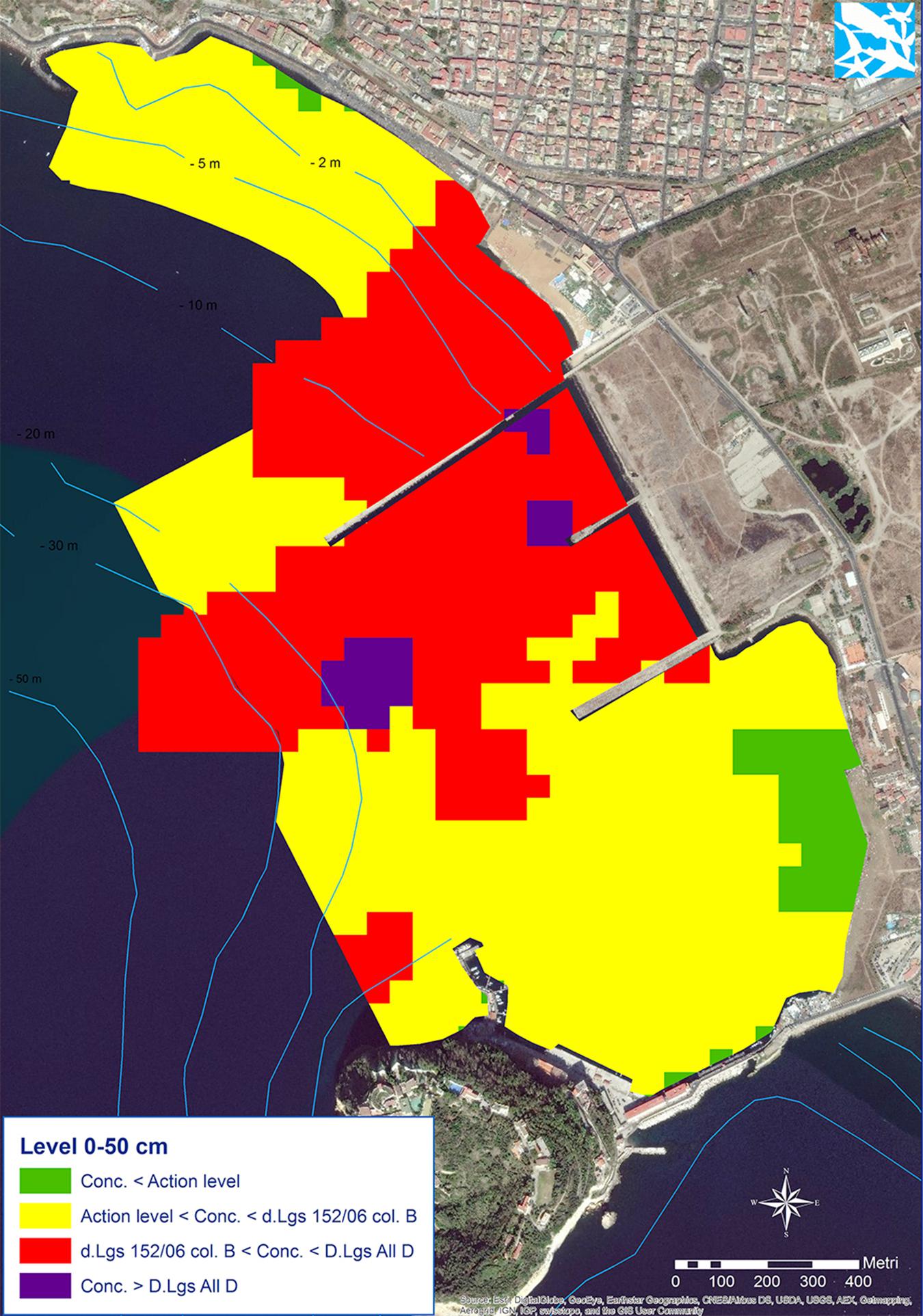
Figure 7. Site of National Interest (SIN) Bagnoli. Concentration of all analyzed contaminants in superficial (0–50 cm) sediments (from ICRAM, 2006, modified).
More recently, a study carried out on three sediment cores, subsampled at high definition (2 cm levels), was conducted in order to reconstruct the historical evolution of the contamination identifying the metal background concentrations. The concentration profiles and enrichment factor (EF) of metals and trace elements, together with the profiles of PAHs and PCBs as chronological constrain, were interpreted also taking into account the historical information on the industrial activity. Several elements (Cd, Cu, Hg, Pb, and Zn) were recognized as responsible for contamination of the marine area, whereas generalized high As concentrations were primarily attributed to hydrothermal submarine springs. The highest EFs of Cu, Pb, and Zn, with depth of between 30 and 100 cm, were associated with the time interval of 1950s–1980s, when the highest production levels were attained; nevertheless, contaminants maintained considerable concentrations up to the top of the core, indicating recent contribution to the marine environment (Romano et al., 2018b).
A recent study, which took into account all the environmental datasets derived from the characterizations carried out between 1999 and 2013, integrated with geomorphology of the sea bottom, allowed to reconstruct the temporal changes of contamination attributable to the steel plant activity, but also recent contaminant supply occurred several years after the dismantling of the industrial area (Sprovieri et al., 2019).
The anthropogenic impact, mainly due to metals and trace elements and PAHs, deriving from the past activities of the industrial site was recognized by Arienzo et al. (2017) and Trifuoggi et al. (2017) in the sediments of outermost and deepest areas of the Gulf of Pozzuoli.
It is evident how this type of industrial facilities can modify the coastal morphology and hydrodynamic and natural sedimentation conditions. This consequently can influence the physical characteristics (texture and composition) of sediments as well as the accumulation and distribution of contaminants. Moreover, the industrial areas may release considerable amounts of contaminants even after the closing and dismantling of industrial facilities.
Augusta Bay (Priolo, Sicily)
The SIN Priolo includes a very large marine coastal area, from Augusta Bay to Siracusa, extending up to 3 km offshore (Figure 2). This case study is focused on a limited sector of the SIN, the Augusta Bay, because of the complexity of the area by geomorphological and environmental viewpoint, and the many and diversified anthropogenic activities operating in the area with the related environmental impact.
From a geological viewpoint, the Meso-Caenozoic carbonates and basalts of the Hyblean plateau outcrop in the mainland, whereas the main lithotypes along the coast are characterized by Pliocene clays and Quaternary biocalcarenites (Carbone, 2011). The Augusta harbor is located within the natural bay, bordered by breakwaters built in the early 1960s and characterized by an intense commercial and industrial maritime activity as well as a huge chemical and petrochemical pole, which has been in operation for several decades. The industrial activities started in the 1950s and quickly developed until the 1980s, making the site the most important hub in Europe. Subsequently, some industries closed, whereas some others are still active. In particular, a chlor-alkali plant, based on mercury cell technology and in operation from 1958 to 2003, was considered as an element of high environmental concern for the marine area owing to the discharge of over 500 tones of Hg directly in the sea in a historical period during which no environmental legislation was active (Croudace et al., 2015).
During the environmental characterization, performed through some implementation phases, a total of 530 sediment cores (2–3 m long) and 39 surface samples were collected. Furthermore, six cores were collected and subsampled at high definition (2 cm levels) for recognizing reference conditions (ICRAM, 2008). The results showed exceptionally high concentrations (Figure 8), mainly located in the southern sector, of Hg (up to 198 mg kg–1 in the surface samples and to 728 mg kg–1 in the deeper ones), associated with very high levels of Ba, hexachlorobenzene (HCB), and PCBs (up to 0.83 mg kg–1 in the surface samples and to 14 mg kg–1 in the deeper ones).
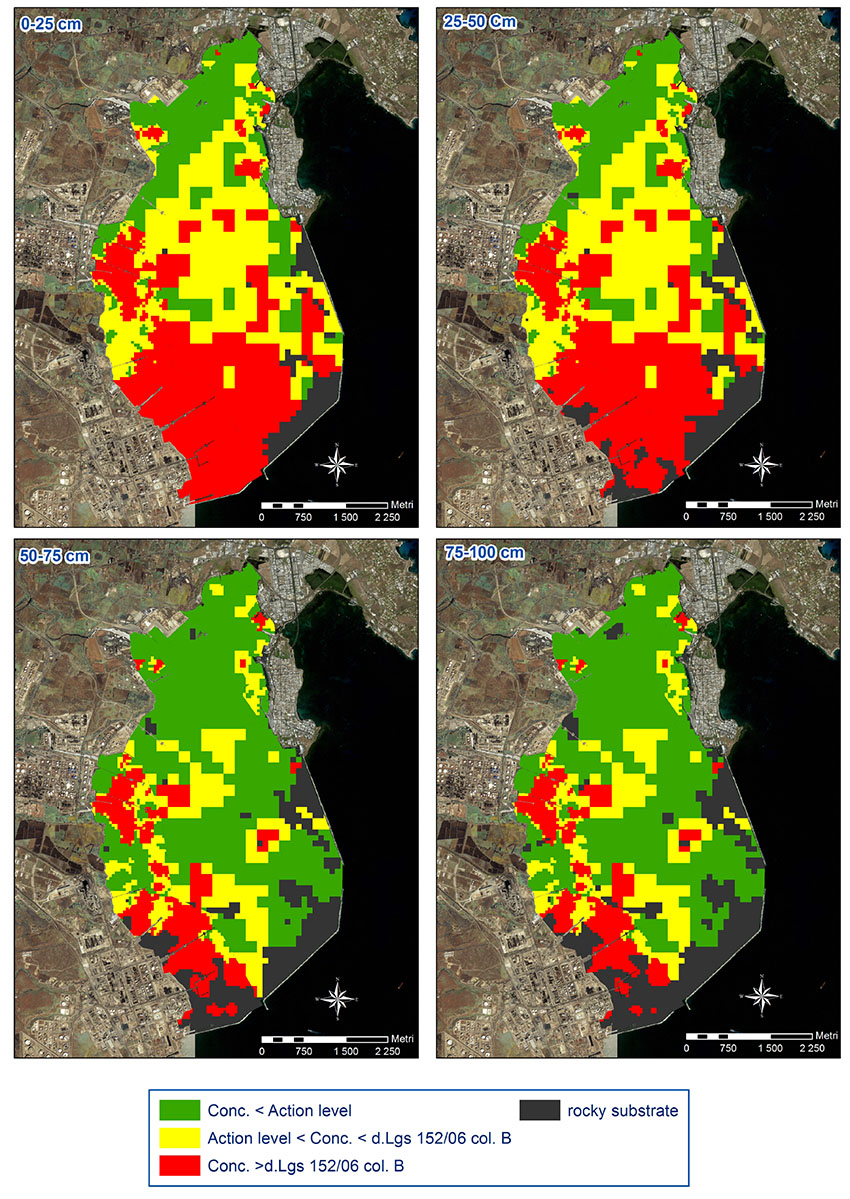
Figure 8. Site of National Interest (SIN) Priolo. Distribution of all analyzed contaminants in four depth intervals (from ICRAM, 2008, modified).
In addition, 10 sediment cores were collected from the whole harbor area and sampled at high resolution (3 cm levels) for a more detailed spatial and vertical reconstruction of contamination patterns and the identification of pre-industrial conditions. Along the core depth, the concurrent increase of contaminant concentrations and of fine sediments was interpreted as the effect of the establishment of dams, which limited water circulation. Three of these cores were dated by means of radiometric methods (210Pb and 137Cs), according to Croudace et al. (2015), allowing to reconstruct the chronology of contamination. The results highlighted that the exceptionally high concentrations of Hg, Ba, and PCBs were attributable to the historical activity of the chlor-alkali plant (Croudace et al., 2015; Romano et al., 2019a).
The bioassays, carried out on three species (Dunaliella tertiolecta, Vibrio fischeri, and Phaeodactylum tricornutum) and two matrices (solid and elutriate), demonstrated toxic and/or hormetic (eutrophic) effects in at least one species and in at least one environmental matrix, highlighting low to high toxicity of the sediments, widespread throughout the bay. The studies carried out on native and transplanted bivalves (Mytilus galloprovincialis) and fishes (Mullus barbatus, Boops boops, Diplodus sp.) highlighted a considerable Hg contamination of tissues (up to 0.45 mg kg–1 w.w. in mussels; up to 0.58 and 1.01 mg kg–1 w.w. in muscle of M. barbatus and Diplodus sp., respectively) and liver (up to 0.94, 2.0, and 5.9 mg kg–1 w.w., respectively), demonstrating the bioavailability of this contaminant (ICRAM, 2008). Besides chemical accumulation, there was also evidence of toxicological effects of Hg in both mussels (M. galloprovincialis) and mullets (M. barbatus). The incidence of micronuclei (MN) in the hemocytes and gills revealed a frequency up to 11‰ in mussels and 9‰ in fish. Similar values have never been previously reported, especially for mussels (Bolognesi et al., 2006), and clearly demonstrate a marked biological reactivity of environmental mercury (Ausili et al., 2008).
Adverse effects due to Hg and PCBs contamination were recognized in benthic foraminifera, applied as environmental indicators in surface samples and sediment cores. They showed, in the most contaminated area, decreased species diversity and increased abundance of pollution-tolerant species. Faunal density was particularly affected by contamination, determining the disappearance of foraminifera in correspondence of the most contaminated subsurface sediments. After the time interval in the 1970s–1980s, benthic foraminifera re-appeared at the sediment–water interface despite the high levels of contamination in the underlying sedimentary layer (Romano et al., 2009b, 2013, 2015). Subsequent research demonstrated that the highly contaminated sediments of the Augusta bay represent an important source of Hg for the Mediterranean Sea basin (Sprovieri et al., 2011). Successive studies, carried out on benthic and demersal fishes, confirmed the Hg bioavailability inside and off the Augusta Bay (Bonsignore et al., 2013, 2015). Further evidence of contamination derived from the Augusta harbor on the coastal zone was obtained by the study of distribution patterns of some contaminants (mainly Hg and PAHs) in sediments collected in neighboring areas and off the Augusta bay (Di Leonardo et al., 2014a, b).
From the environmental results, it can be deduced that both chemical and textural characteristics of sediments may be considered as proxies of the anthropogenic impact; for this reason, the identification of the source of contamination should be based not only on spatial distribution but also on the historical reconstruction. In addition, because of the known persistence of most of contaminants examined here, their sedimentary store should be considered in the evaluation of future potential impacts on the marine environment.
Sulcis (Sardinia)
The SIN Sulcis includes a large sector of southwestern Sardinia, from Piscinas to Sant’Antioco lagoon where mining activities strongly impacted the marine areas, and the eastern side close to Cagliari, where the industrial activity is prevalent (Sarroch industrial plant). This case study is focused on the southwestern sector, characterized by volcanism of Tertiary age, which affected Cambrian dolostones and limestones, producing widespread mineralization, which was used since pre-Roman times (Figure 9). The mining district includes over 40 dismissed mines, which exploited mainly base metal (Zn, Pb, Ag, and Ba) and calamine (Zn and Pb) deposits, constituting the main economic resource of the area between the 19th and 20th centuries. Nowadays, large outcrops of sulfide and oxide ores, as well as the products of long-lasting mining activity, are responsible for strong contamination of soil, streams, and groundwater (Cidu, 2009, 2011).
Other kinds of anthropogenic impact, which may affect the environmental status of the marine area, are due to the activities carried out in Sant’Antioco (harbor, municipal wastes, tourist facilities, and a disused factory for the production of magnesium oxide) and those of the industrial sites of Sarroch and Portoscuso-Portovesme; the first one includes mainly petrochemical industries, whereas iron and steel industries and an electric power plant are present in the second one. In the framework of the environmental characterization, carried out in 2015, a total of 415 surface and subsurface sediment samples were analyzed, among the other parameters, for grain size and mineralogical content, metals and trace elements, PAHs, and PCBs (ISPRA, 2015). The analytical results highlighted almost exclusively sandy sediments and a mineralogical composition reflecting the types of rocks outcropping inland also including processing residues derived from exploiting activities (Figure 10).
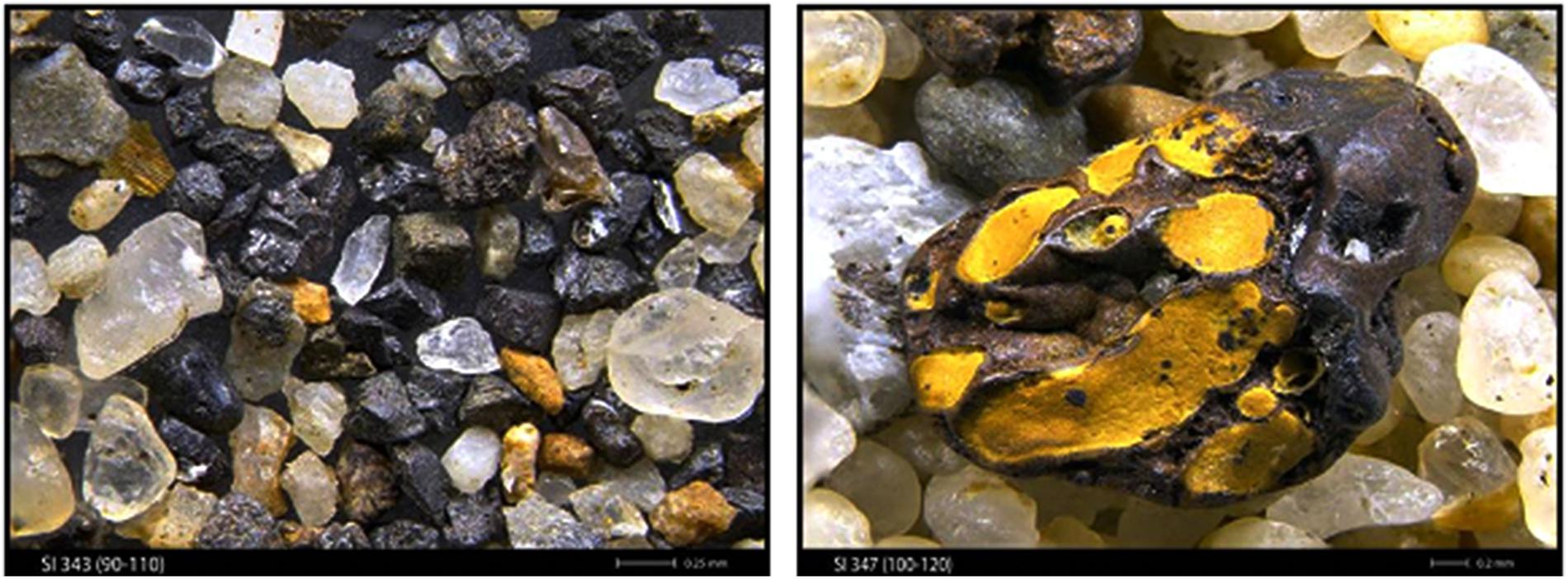
Figure 10. View under stereo microscope of sediment. Mining residues in the sediments (ISPRA, 2015).
Metal and trace element concentrations confirmed the presence of very high levels of Cd (up to 164 mg kg–1), Pb (up to 3,423 mg kg–1), and Zn (up to 42,764 mg kg–1) over the entire area and, more locally, significant concentrations of As (up to 72 mg kg–1) and Hg (up to 12 mg kg–1). Most of the Cd, Pb, and Zn concentrations exceeded considerably local BGVs, pointing out an anthropogenic enrichment for these elements, which is attributable to the past exploiting activity. This enrichment is well documented in the deeper sediment levels, whereas the still high concentration recorded in the surface ones are due to the weathering of mine waste residues, still present in the mainland (ISPRA, 2015; Romano et al., 2017).
Differently from the northern coastal belt, sediments of the Sant’Antioco lagoon resulted widely variable as regards texture, mainly sandy with a significant presence of the fine fraction and, locally, of gravel; anthropogenic grains were abundant in several stations. For most of the trace elements, the concentrations were fairly homogeneous, with the exception mainly of Cd, but also Zn, Pb, and Hg, which showed, in the upper 50 cm of some stations, higher concentrations than the average values of the area.
Marine sediments of the eastern sector of SIN, in front of the industrial site of Sarroch, were characterized mainly by sand with significant pelitic fraction and grains of potential anthropogenic origin in some superficial samples. As regards chemical parameters, the results did not show any environmental criticality.
A specific study was conducted on three sediment cores as representative of the different areas (mining, lagoonal, and industrial areas), subsampled at high resolution (2 cm levels), for reconstructing the concentration profiles of metals and trace elements and recognizing the reference conditions. The analytical results highlighted different concentration profiles and range of values for each area; in particular, the profiles of core collected in the mining area showed the strongest anthropogenic enrichment for all the analyzed parameters (Cd, Hg, Pb, and Zn) with higher and variable concentrations in the superficial levels and their significant reduction, with steady values, in the underlying ones (Figure 11). This behavior, associated with the determined BGVs and the presence of mine waste minerals, confirmed the correspondence, in the upper core, of anthropogenic trace metal enrichment due to the exploiting over industrial scale, whereas the still high metal enrichment in sediment surface levels suggested a present impact due to mine dumps and tailings weathering (Romano et al., 2017). The improvement of core dating by means of luminescence method confirmed, for the strong metal enrichment in the upper 20 cm of the core, the attribution to historical mining activity (Sechi et al., 2018).
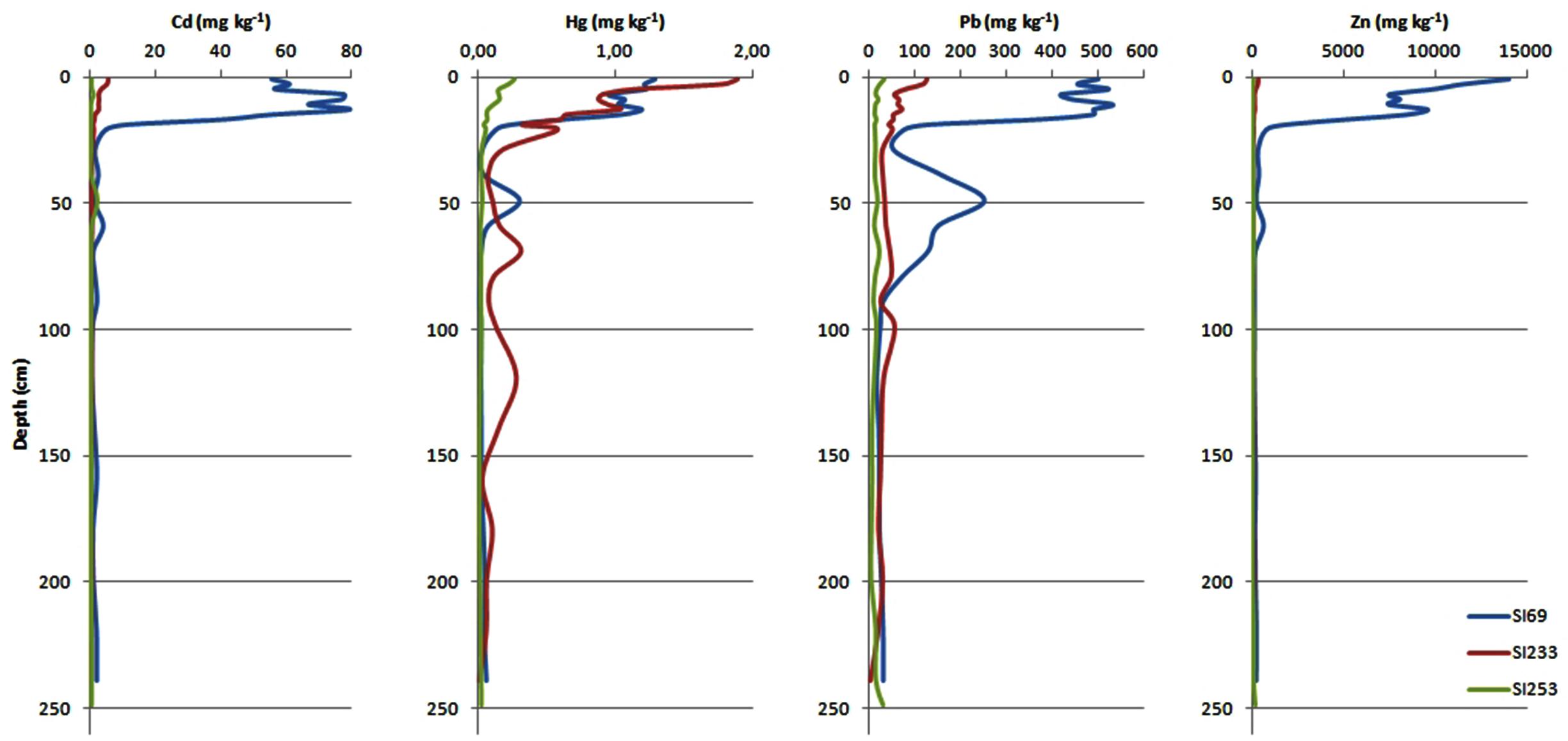
Figure 11. Concentration profiles for main elements in the three cores from mining (SI69), lagoonal (SI233), and industrial area (SI253) (ISPRA, 2015).
Also, the mobility Cd, Pb, and Zn was investigated in an integrative study by means of a sequential extraction procedure (five steps). The results displayed the high mobility of Cd and Pb, with higher concentrations in the first phase, of metals physically adsorbed and bound to the carbonate, and in the second one, referable to metals present in the reductive phase bound to manganese–iron oxides. Cd was extracted in percentages ranging from 15 to 87% and from 6 to 81% in the first and second steps, respectively, whereas, as regards Pb, the percentages of the first and second phases were 26–72% and 11–39%, respectively. Also, Zn was found to be mobile, because it was mainly extracted in the second step, in percentages ranging between 22 and 99%. In spite of this, bioassays (V. fischeri, D. tertiolecta, Brachionus plicatilis) carried out on both solid and elutriate did not highlight toxic response. These apparently conflicting outcomes were attributed to the fact that biogeochemical features of sea bottom and its aquatic/biotic interface constitute a dynamic and complex system, including an ensemble of variables, which in some cases, make it difficult to obtain univocal response by different lines of evidence (Romano et al., 2019b).
The study of this SIN established a milestone for the environmental assessment in marine areas close to mine districts, that is, the essential need to determine local BGVs for metals and trace elements in order to assess their actual anthropogenic contribution. This is because the mined contaminants are enriched not only in mining residues but also throughout the geological landscape. The study of this SIN also revealed that contamination from mine waste deposits could persist after the end of exploiting activities.
Conclusion
This review examines the environmental surveys carried out in the early 2000s on transitional and marine coastal areas included in the SINs, when a specific legislation was missing. The wide variability that characterizes both the natural environmental setting and type/degree of anthropogenic impact of the Italian SINs imposed the adoption of an investigative approach based on general scientific-based principles, but also adaptable to large scale. This approach, highly flexible as regards sampling strategy and investigated parameters, considered sediments as the preferential matrix, owing to their conservative feature, for the assessment of marine contamination; nevertheless, ecotoxicological and biological tests were also considered. Integrative analyses, such as the study of dated sediment cores for the determination of local BGVs or sequential extractions to verify metal mobility, were also included, according to specific conditions of studied sites.
The synthesis of results reported in this review allows us to draw some general conclusions on the environmental quality status of the Italian marine-coastal and transitional areas included in SINs. In all cases, the characterization activities recognized a direct correlation of organic and inorganic contaminants with past or present activities in the area, identifying the actual anthropogenic contribution of metals and trace elements naturally occurring in the sediments. It was highlighted that the extent of the contamination was directly correlated not only with type of activity and amount of the released contaminants but also with geomorphological, bathymetric, and sedimentological characteristics of the area.
The special focus on four different sites allowed us to develop a set of general criteria for environmental characterization of contaminated marine areas:
– Grain size analysis is a basic part of environmental characterization both because sediment texture influences contaminant accumulation and because it may be a proxy of the anthropogenic impact.
– Although sediments are the eligible matrix for contamination assessment, studies of bioaccumulation and adverse effects on biota are necessary to recognize the actual environmental risk.
– The environmental characterization has to be based not only on surface samples but also on sediment cores; the latter can be used to reconstruct the spatial and vertical distribution of contaminants, as well as the historical evolution of contamination and the reference conditions in pre-impacted times.
– Local BGVs must be calculated in areas affected by natural geochemical enrichment in order to isolate the actual anthropogenic contribution. The determination of these values must be based on sediment cores that allow for the collection of undisturbed and uncontaminated sediments in the deeper levels.
– The SINs may also be considered as laboratories for studying the effects of contaminants on marine environment and identifying reliable new environmental indicators, not traditionally considered.
Author Contributions
All authors listed have made a substantial, direct and intellectual contribution to the work, and approved it for publication. Each author contributed equally to all sections of the manuscript.
Conflict of Interest
The authors declare that the research was conducted in the absence of any commercial or financial relationships that could be construed as a potential conflict of interest.
Acknowledgments
We thank Andrea Salmeri for his support in the images realization and are very grateful to the two reviewers for their comments, which were greatly helpful for the improvement of the manuscript.
References
Annicchiarico, C., Biandolino, F., Cardellicchio, N., Di Leo, A., Giandomenico, S., and Prato, E. (2007). Predicting toxicity in marine sediment in Taranto Gulf (Ionian Sea, Southern Italy) using sediment quality guidelines and a battery bioassay. Ecotoxicology 16, 239–246. doi: 10.1007/s10646-006-0123-z
Apitz, S. E., Degetto, S., and Cantaluppi, C. (2009). The use of statistical methods to separate natural background and anthropogenic concentrations of trace elements in radio-chronologically selected surface sediments of the Venice lagoon. Mar. Pollut. Bull. 58, 402–414. doi: 10.1016/j.marpolbul.2008.10.007
Arienzo, M., Donadio, C., Mangoni, O., Bolinesi, F., Stanislao, C., Trifuoggi, M., et al. (2017). Characterization and source apportionment of polycyclic aromatic hydrocarbons (PAHs) in the sediments of gulf of Pozzuoli (Campania, Italy). Mar. Pollut. Bull. 124, 480–487. doi: 10.1016/j.marpolbul.2017.07.006
ARPAT (2007). Monitoraggio del Mercurio su Matrici Biologiche Della Laguna di Orbetello. Periodo 2004-2006: Technical report. Florence: ARPAT, 66.
Atkinson, C. A., Jolley, D. F., and Simpson, S. L. (2007). Effect of overlying water pH, dissolved oxygen, salinity and sediment disturbances on metal release and sequestration from metal contaminated marine sediments. Chemosphere 69, 1428–1437. doi: 10.1016/j.chemosphere.2007.04.068
Ausili, A., Bergamin, L., Maggi, C., and Romano, E. (2011). Determinazione dei Valori di Fondo Dei Sedimenti Lagunari: Technical report. Cagliari: ARPAS – Direzione Generale, 31.
Ausili, A., Gabellini, M., Cammarata, G., Fattorini, D., Benedetti, M., Pisanelli, B., et al. (2008). Ecotoxicological and human health risk in a petrochemical district of southern Italy. Mar. Environ. Res. 66, 215–217. doi: 10.1016/j.marenvres.2008.02.062
Ausili, A., Romano, E., Mumelter, E., and Tornato, A. (2012). “Stato dell’arte sulle bonifiche delle aree marine e di transizione interne ai SIN,” in Atti Workshop “Siti Contaminati. Esperienze negli interventi di risanamento” (Universitá di Catania: TEAM PA), 27–45.
Barberi, F., Hill, D. P., Innocenti, F., Luongo, G., and Treuil, M., (eds.) (1984). The 1982-1984 bradyseismic crisis at Phlegrean Fields (Italy). Bull Volcanol 47, 173–411.
Birch, G. F. (2017). Determination of sediment metal background concentrations and enrichment in marine environments – A critical review. Sci. Total Environ. 580, 813–831. doi: 10.1016/j.scitotenv.2016.12.028
Bolognesi, C., Perrone, E., Roggieri, P., and Sciutto, A. (2006). Bioindicators in monitoring long term genotoxic impact of oil spill: Haven case study. Mar. Environ. Res. 62, 287–291. doi: 10.1016/j.marenvres.2006.04.047
Bonsignore, M., Manta, D. S., Oliveri, E., Sprovieri, M., Basilone, G., Bonanno, A., et al. (2013). Mercury in fishes from Augusta Bay (southern Italy): risk assessment and health implication. Food Chem. Toxicol. 56, 184–194. doi: 10.1016/j.fct.2013.02.025
Bonsignore, M., Tamburrino, S., Oliveri, E., Marchetti, A., Durante, C., Berni, A., et al. (2015). Tracing mercury pathways in Augusta Bay (southern Italy) by total concentration and isotope determination. Environ. Pollut. 205, 178–185. doi: 10.1016/j.envpol.2015.05.033
Burton, G. A. Jr. (2002). Sediment quality criteria in use around the world. Limnology 3, 65–75. doi: 10.1007/s102010200008
Cannata, C. B., Cianflone, G., Vespasiano, G., and De Rosa, R. (2016). Preliminary analysis of sediments pollution of the coastal sector between Crotone and Strongoli (Calabria – southern Italy). Rend Online Soc. Geol It 38, 17–20. doi: 10.3301/rol.2016.06
Carbone, S. (2011). Note Illustrative della Carta Geologica d’Italia alla Scala 1:50.000 – Foglio 641 Augusta. Roma: Servizio Geologico d’Italia, 247.
Cardellicchio, N., Annicchiarico, C., Di Leo, A., Giandomenico, S., and Spada, L. (2015). The Mar Piccolo of Taranto: an interesting marine ecosystem for the environmental problems studies. Environ. Sci. Pollut. Res. 23, 12495–12501. doi: 10.1007/s11356-015-4924-6
CCME (2001). Canadian Sediment Quality Guidelines for the Protection of Aquatic Life. Winnipeg: Canadian Council of Ministry of the Environment: CCME EPC-98E.
Celico, P., Dall’Aglio, M., Ghiara, M. R., Stanzione, D., Brondi, M., and Prosperi, M. (1992). Geochemical monitoring of the thermal fluids in the Phlegrean Fields from 1970 to 1990. Boll Soc Geol It 111, 409–442.
Cidu, R. (2009). Impact of past mining activity on the quality of groundwater in SW Sardinia (Italy). J. Geochem. Explor. 100, 125–132. doi: 10.1016/j.gexplo.2008.02.003
Cidu, R. (2011). Mobility of aqueous contaminants at abandoned mining sites: insights from case studies in Sardinia with implications for remediation. Environ. Earth Sci. 64, 503–512. doi: 10.1007/s12665-010-0874-y
Croudace, I. W., Romano, E., Ausili, A., Bergamin, L., and Rothwell, G. (2015). “X-ray core scanners as an environmental forensic tool: a case study of polluted harbor sediment (Augusta Bay, Sicily),” in Micro-XRF Studies of Sediment Core, eds I. W. Croudace and R. G. Rothwell (Berlin: Springer), 393–421. doi: 10.1007/978-94-017-9849-5_15
Deino, A. L., Orsi, G., de Vita, S., and Piochi, M. (2004). The age of the Neapolitan Yellow Tuff caldera-forming eruption (Campi Flegrei caldera, Italy) assessed by 40Ar/39Ar dating method. J. Volcanol. Geotherm. Res. 133, 157–170. doi: 10.1016/S0377-0273(03)00396-2
Del Gaudio, C., Aquino, I., Ricciardi, G. P., Ricco, C., and Scandone, R. (2010). Unrest episodes at Campi Flegrei: a reconstruction of vertical ground movements during 1905-2009. J. Volcanol. Geotherm. Res. 195, 48–56. doi: 10.1016/j.jvolgeores.2010.05.014
den Besten, P. J. (2007). “Risk assessment approaches in European countries,” in Sustainable management of sediment resources: sediment risk management and communication, ed. S. Heise (Amsterdam: Elsevier), 153–200.
Di Leonardo, R., Adelfio, G., Bellanca, A., Chiodi, M., and Mazzola, S. (2014a). Analysis and assessment of trace element contamination in offshore sediments of the Augusta Bay (SE Sicily): a multivariate statistical approach based on canonical correlation analysis and mixture density estimation approach. J. Sea Res. 85, 428–442. doi: 10.1016/j.seares.2013.07.015
Di Leonardo, R., Mazzola, A., Tramati, C. D., Vaccaro, A., and Vizzini, S. (2014b). Highly contaminated areas as sources of pollution for adjoining ecosystems: The case of Augusta Bay (Central Mediterranean). Mar. Pollut. Bull. 89, 417–426. doi: 10.1016/j.marpolbul.2014.10.023
Frontalini, F., Coccioni, R., and Bucci, C. (2009). Benthic foraminiferal assemblages and trace element contents from the lagoons of Orbetello and Lesina. Environ. Monit. Assess. 170, 245–260. doi: 10.1007/s10661-009-1229-6
Gabellini, M., Ausili, A., Romano, E., Geraldini, S., Tornato, A., and Dastoli, S. (2011). “Sedimenti contaminati in Italia: stato dell’arte, gestione e bonifica,” in Atti Convegno REMTECH, Ferrara, 221–226.
GAU (2010). Dating of Sediment Cores from the Orbetello Lagoon (Tuscany, Italy) Technical Report. Southampton: Geosciences Advisory Unit, 32.
Grassi, S., and Netti, R. (2000). Sea water intrusion and mercury pollution of some coastal aquifers in the province of Grosseto (Southern Tuscany – Italy). J. Hydrol. 237, 198–211. doi: 10.1016/S0022-1694(00)00307-3
Guo, Y., and Yang, S. (2016). Heavy metal enrichment in the Changjiang (Yangtze River) catchment and n the inner shelf of the East China Sea over the last 150 years. Sci. Total Environ. 543, 105–115. doi: 10.1016/j.scitotenv.2015.11.012
ICRAM (2006). Progetto Preliminare di Bonifica Dell’area Marina Inclusa Nella Perimetrazione Del Sito di Bonifica di Napoli Bagnoli-Coroglio: Technical report. Roma: ICRAM, 116.
ICRAM (2008). Progetto Preliminare di Bonifica Della Rada di Augusta Inclusa nel sito di Bonifica di Interesse Nazionale di Priolo. Fase I e II. Elaborazione Definitiva. Technical report. Roma: ICRAM, 253.
ICRAM and Stazione Zoologica Anton Dohrn (2006). Caratterizzazione Ambientale Dei Fondali e Degli Arenili Inclusi Nella Perimetrazione Del sito di bonifica di Napoli Bagnoli-Coroglio. Relazione tecnica conclusiva. Technical report. Roma: ICRAM, 852.
Innocenti, C., Salmeri, A., Navach, A., Piccione, M. E., Rossi, L., and Trinchera, G. (2005). “Procedure di interpretazione dei risultati della caratterizzazione di sedimenti contaminati,” in Atti 9a Conferenza Nazionale ASITA, Federazione italiana delle Associazioni Scientifiche per le Informazioni Territoriali e Ambientali, Catania, 6.
ISPRA (2008). Progetto Preliminare di Bonifica dell’area Lagunare Antistante lo Stabilimento ex-SITOCO Inclusa all’interno della Perimetrazione del sito di Bonifica di Interesse Nazionale di Orbetello – Area Ex Sitoco. Technical report. Rome: Istituto superiore per la protezione e la ricerca ambientale, 107.
ISPRA (2009a). Interventi per il Risanamento Delle Aree Lagunari di Orbetello - Laguna di Ponente: Premesse di progetto. Technical Report. Rome: Istituto superiore per la protezione e la ricerca ambientale, 115.
ISPRA (2009b). Interventi per il Risanamento delle aree lagunari di Orbetello – Laguna di Levante. Premesse di progetto. Technical Report. Rome: Istituto superiore per la protezione e la ricerca ambientale, 105.
ISPRA (2015). Caratterizzazione Ambientale dell’area Marino Costiera Prospiciente il sito di Bonifica di Interesse Nazionale del Sulcis-Iglesiente-Guspinese. Risultati analitici e valutazione dei dati. Technical report. Rome: Istituto superiore per la protezione e la ricerca ambientale, 120.
ISPRA (2019). Annuario dei dati ambientali 2018. Stato dell’ambiente 84/2019. Rome: Istituto superiore per la protezione e la ricerca ambientale, 2238.
Kowalewska, G., Belzunce-Segarra, M. J., Schubert, B., Heininger, P., and Heise, S. (2011). “The role of sediments in coastal monitoring,” in Chemical marine monitoring: Policy framework and analytical trends, eds P. Quevauviller, P. Roose, and G. Verreet (Hoboken, NJ: John Wiley & Sons), 377–395. doi: 10.1002/9781119990826.ch12
Lenzi, M., Finoia, M. G., Persia, E., Comandi, S., Gargiulo, D., Solari, D., et al. (2005). Biogeochemical effects of disturbance in shallow water sediment by macroalgae harvesting boats. Mar. Pollut. Bull. 50, 512–519. doi: 10.1016/j.marpolbul.2004.11.038
Lenzi, M., Palmieri, R., and Porrello, S. (2003). Restoration of the eutrophic Orbetello lagoon (Tyrrhenian Sea, Italy): water quality management. Mar. Pollut. Bull. 46, 1540–1548. doi: 10.1016/S0025-326X(03)00315-1
Li, X., Wai, O. W. H., Li, Y. S., Coles, B. J., Ramsey, M. H., and Thornton, I. (2000). Heavy metal distribution in sediment profiles of the pearl river estuary, South China. Appl. Geochem. 15, 567–581. doi: 10.1016/S0883-2927(99)00072-4
Long, E. R., MacDonald, D. D., Smith, S. L., and Calder, F. D. (1995). Incidence of adverse biological effects within ranges of chemical concentrations in marine and estuarine sediments. Environ. Manage. 19, 81–97. doi: 10.1007/bf02472006
Losso, C., Arizzi Novelli, A., Picone, M., Marchetto, D., Pessa, G., Molinaroli, E., et al. (2004). Evaluation of surficial sediment toxicity and sediment physico-chemical characteristics of representative sites in the Lagoon of Venice (Italy). J. Mar. Syst. 51, 281–292. doi: 10.1016/j.jmarsys.2004.05.016
MacDonald, D. A., Carr, R. S., Calder, F. D., Long, E. R., and Ingersoll, C. G. (1996). Development and evaluation of sediment quality guidelines for Florida coastal waters. Ecotoxicology 5, 253–278. doi: 10.1007/BF00118995
MacDonald, D. D., Carr, R. S., Eckenrod, D., Greening, H., Grabe, S., Ingersoll, C. G., et al. (2004). Development, evaluation, and application of sediment quality targets for assessing and managing contaminated sediments in tampa bay, Florida. Arch. Environ. Contam. Toxicol. 46, 147–161. doi: 10.1007/s00244-003-2270-z
Macfarlane, M. W., and MacDonald, D. D. (2002). Criteria for Managing Contaminated Sediment in British Columbia: DRAFT P3 version. Victoria: Ministry of Water, Land and Air Protection.
Matschullat, J., Ottestein, R., and Reiman, C. (2000). Geochemical background – can we calculate it? Environ. Geol. 39, 990–1000. doi: 10.1007/s002549900084
Miniero, R., Beccaloni, E., Carere, M., Ubaldi, A., Mancini, L., Marchegiani, S., et al. (2013). Mercury (Hg) and methyl mercury (MeHg) concentrations in fish from the coastal lagoon of Orbetello, central Italy. Mar. Pollut. Bull. 76, 365–369. doi: 10.1016/j.marpolbul.2013.08.012
National Research and Council (2007). Sediment Dredging at Superfund Megasites: Assessing the Effectiveness. Washington, D.C.: National Academies Press, 316.
Ospar Commission (2004a). OSPAR/ICES Workshop on Evaluation and Update of BRCs and EACs. London: OSPAR Commission, 167.
Ospar Commission (2004b). Overview of Contracting Parties National Action Levels for Dredged material. London: OSPAR Commission, 22.
Passaro, S., Barra, M., Saggiomo, R., Di Giacomo, S., Leotta, A., Uhlen, H., et al. (2013). Multi-resolution morpho-bathymetric survey results at the Pozzuoli – Baia underwater archaeological site (Naples, Italy). J. Archaeol. Sci. 40, 1268–1278. doi: 10.1016/j.jas.2012.09.035
Protano, G., Riccobono, F., and Sabatini, G. (1998). “La cartografia geochimica della Toscana meridionale. Criteri di realizzazione e rilevanza ambientale attraverso gli esempi di Hg, As, Sb, Pb e Cd,” in Cartografia Geochimica Ambientale. Primi esempi di applicazione: Calabria, Monti Peloritani, Sardegna e Toscana meridionale (Roma: Servizio Geologico Nazionale - Istituto Poligrafico e Zecca dello Stato), 109–140.
Reimann, C., Ladenberger, A., Birke, M., and de Caritat, P. (2015). Low density geochemical mapping and mineral exploration: application of the mineral system concept. Geochem. Explor. Environ. Anal. 16, 48–61. doi: 10.1144/geochem2014-327
Reimann, C., Matschullat, J., Birke, M., and Salminen, R. (2010). Antimony in the environment: lessons from geochemical mapping. Appl. Geochem. 25, 175–198. doi: 10.1016/j.apgeochem.2009.11.011
Rolandi, G., Bellucci, F., Heizler, M. T., Belkin, H. E., and De Vivo, B. (2003). Tectonic controls on the genesis of ignimbrites from the Campanian Volcanic Zone, southern Italy. Mineral Petrol. 79, 3–31. doi: 10.1007/s00710-003-0014-4
Romano, E., Ausili, A., Zharova, N., Celia Magno, M., Pavoni, B., and Gabellini, M. (2004). Marine sediment contamination of an industrial site at Port of Bagnoli, Gulf of Naples, Southern Italy. Mar. Pollut. Bull. 49, 487–495. doi: 10.1016/j.marpolbul.2004.03.014
Romano, E., Bergamin, L., Ausili, A., and Celia Magno, M. (2016). Evolution of the anthropogenic impact in the Augusta Harbor (Eastern Sicily, Italy) in the last decades: benthic foraminifera as indicators of environmental status. Environ. Sci. Pollut. Res. 23, 10514–10528. doi: 10.1007/s11356-015-5783-x
Romano, E., Bergamin, L., Ausili, A., Pierfranceschi, G., Maggi, C., Sesta, G., et al. (2009a). The impact of the Bagnoli industrial site (Naples, Italy) on sea-bottom environment. Chemical and textural features of sediments and the related response of benthic foraminifera. In: Romano E., Bergamin L. (eds), Foraminifera and Marine Pollution (special volume). Mar. Pollut. Bull. 59, 244–255. doi: 10.1016/j.marpolbul.2009.09.017
Romano, E., Bergamin, L., Finoia, M. G., Celia Magno, M., Ausili, A., and Gabellini, M. (2009b). “The effects of human impact on benthic foraminifera in the Augusta harbour (Sicily, Italy),” in Integrated Coastal Zone Management, eds E. Moksness, E. Dahl, and J. Støttrup (Hoboken, NJ: Wiley-Blackwell). 97–115. doi: 10.1002/9781444316285.ch8
Romano, E., Bergamin, L., Canepa, M., Maggi, C., and Ausili, A. (2018a). Definizione delle Province Geochimiche a Mare e dei Relativi Valori di Fondo nei Sedimenti Marini. Ispra: Linee Guida SNPA.
Romano, E., Bergamin, L., Celia Magno, M., Pierfranceschi, G., and Ausili, A. (2018b). Temporal changes of metal and trace element contamination in marine sediments due to a steel plant: the case study of Bagnoli (Naples, Italy). Appl. Geochem. 88, 85–94. doi: 10.1016/j.apgeochem.2017.05.012
Romano, E., Bergamin, L., Celia Magno, M., and Ausili, A. (2013). Sediment characterization of the highly impacted Augusta harbour (Sicily, Italy): modern benthic foraminifera in relation to grain-size and sediment geochemistry. Environ. Sci. Process. Impacts 15, 930–946. doi: 10.1039/C3EM30824C
Romano, E., Bergamin, L., Croudace, I. W., and Ausili, A. (2019a). “Integrated sedimentological and geochemical approach for the reconstruction of anthropogenic impact in the Augusta Harbor,” in Proceeding of the 34th IAS International Meeting of Sedimentology, Rome.
Romano, E., Bergamin, L., Pierfranceschi, G., Maggi, C., Berducci, M. T., and Ausili, A. (2019b). Conflicting outcomes of integrated approach for sediment quality assessment in Sardinian coastal area subjected to mining activities. J. Soils Sediments 32. doi: 10.1007/s11368-019-02489-y
Romano, E., Bergamin, L., Croudace, I. W., Ausili, A., Maggi, C., and Gabellini, M. (2015). Establishing geochemical background levels of selected trace elements in areas having geochemical anomalies: the case study of the Orbetello lagoon (Tuscany, Italy). Environ. Pollut. 202, 96–103. doi: 10.1016/j.envpol.2015.03.01
Romano, E., Bergamin, L., Finoia, M. G., Carboni, M. G., Ausili, A., and Gabellini, M. (2008). Industrial pollution at Bagnoli (Naples, Italy): Benthic foraminifera as a tool in integrated programs of environmental characterization. Mar. Pollut. Bull. 56, 439–457. doi: 10.1016/j.marpolbul.2007.11.003
Romano, E., De Giudici, G., Bergamin, L., Andreucci, S., Maggi, C., Pierfranceschi, G., et al. (2017). The marine sedimentary record of natural and anthropogenic contribution from the Sulcis-Iglesiente mining district (Sardinia, Italy). Mar. Pollut. Bull. 122, 331–343. doi: 10.1016/j.marpolbul.2017.06.070
Santschi, P. H., Presley, B. J., Wade, T. L., Garcia-Romero, B., and Baskaran, M. (2001). Historical contamination of PAHs, PCBs, DDTs, and heavy metals in Mississippi River Delta, Galveston Bay and Tampa Bay sediment cores. Mar. Environ. Res. 52, 51–79. doi: 10.1016/s0141-1136(00)00260-9
Sechi, D., Andreucci, S., De Giudici, G., and Pascucci, V. (2018). Luminescence dating of a Middle Late Holocene lower shoreface (Sardinia, Italy). Alp Mediterr. Quat. 31, 189–192.
Signa, G., Mazzola, A., Doriana Tramati, C., and Vizzini, S. (2017). Diet and habitat use influence Hg and Cd transfer to fish and consequent biomagnification in a highly contaminated area: Augusta Bay (Mediterranean Sea). Environ. Pollut. 230, 394–404. doi: 10.1016/j.envpol.2017.06.027
Spencer, K. L., and Macleod, C. L. (2002). Distribution and partitioning of heavy metals in estuarine sediment cores and implications for the use of sediment quality standards. Hydrol. Earth Syst. Sci. 6, 989–998. doi: 10.5194/hess-6-989-2002
Sprovieri, M., Oliveri, E., Di Leonardo, R., Romano, E., Ausili, A., Gabellini, M., et al. (2011). The key role played by the Augusta basin (southern Italy) in the mercury contamination of the Mediterranean Sea. J. Environ. Monit. 13, 1753–1760.
Sprovieri, M., Passaro, S., Ausili, A., Bergamin, L., Finoia, M. G., Gherardi, S., et al. (2019). Integrated approach of multiple environmental datasets for the assessment of sediment contamination in marine areas affected by long lasting industrial activity: the case study of Bagnoli (southern Italy). J. Soils Sediments 20, 1692–1705. doi: 10.1007/s11368-019-02530-0
Succi, M. C. (2015). I Foraminiferi Bentonici Come Indicatori di Stress Ambientale in Aree Lagunari e Portuali ad Elevato Impatto Antropico. PhD thesis Sapienza Università di Roma, Rome, 186.
Suedel, B. C., Boraczek, J. A., Peddicord, R. K., Clifford, P. A., and Dillon, T. M. (1994). “Trophic transfer and biomagnification potential of contaminants in aquatic ecosystems,” in Reviews of Environmental Contamination and Toxicology. Reviews of Environmental Contamination and Toxicology (Continuation of Residue Reviews), Vo. 136, ed. G.W. Ware (New York, NY: Springer), 21–89. doi: 10.1007/978-1-4612-2656-7_2
Trifuoggi, M., Donadio, C., Mangoni, O., Ferrara, L., Bolinesi, F., Nastro, R. A., et al. (2017). Distribution and enrichment of trace metals in surface marine sediments in the Gulf of Pozzuoli and off the coast of the brownfield metallurgical site of Ilva of Bagnoli (Campania, Italy). Mar. Pollut. Bull. 124, 502–511. doi: 10.1016/j.marpolbul.2017.07.03
U. S. Environmental Protection Agency (1996). Calculation and Evaluation of Sediment Effect Concentrations for the Amphipod Hyalella azteca and the Midge Chironomus riparius. EPA-905/R-96/008. Chicago IL: USEPA.
U. S. Environmental Protection Agency (1997). The Incidence and Severity of Sediment Contamination in Surface Waters of the United States: EPA 823-R-97-006, Vol. 1–3. Washington, DC: Science and Technology Office.
van de Meent, D., Aldenberg, T., Canton, J. H., van Gestel, C. A. M., and Slooff, W. (1990). Desire for Levels – Background Study for the Policy Document Setting Environmental Quality Standards for Water and Soil: RIVM Rapport 670101 002. Bilthoven: Rijksinstituut voor Volksgezondheid en Milieu (RIVM).
Wenning, R. J., Batley, G. E., Ingersoll, C. G., and Moore, D. W., (eds.) (2005). Use of Sediment Quality Guidelines (SQGs) and Related Tools for the Assessment of Contaminated Sediments. Pensacola, FL: Society of Environmental Toxicology and Chemistry.
Keywords: sediment contamination, Sites of National Interest, coastal areas, anthropogenic impact, Italy
Citation: Ausili A, Bergamin L and Romano E (2020) Environmental Status of Italian Coastal Marine Areas Affected by Long History of Contamination. Front. Environ. Sci. 8:34. doi: 10.3389/fenvs.2020.00034
Received: 28 May 2019; Accepted: 05 March 2020;
Published: 15 April 2020.
Edited by:
Mario Sprovieri, Italian National Research Council, ItalyReviewed by:
Francois L. L. Muller, National Sun Yat-sen University, TaiwanJulian Blasco, Spanish National Research Council, Spain
Copyright © 2020 Ausili, Bergamin and Romano. This is an open-access article distributed under the terms of the Creative Commons Attribution License (CC BY). The use, distribution or reproduction in other forums is permitted, provided the original author(s) and the copyright owner(s) are credited and that the original publication in this journal is cited, in accordance with accepted academic practice. No use, distribution or reproduction is permitted which does not comply with these terms.
*Correspondence: Elena Romano, ZWxlbmEucm9tYW5vQGlzcHJhbWJpZW50ZS5pdA==
 Antonella Ausili
Antonella Ausili Luisa Bergamin
Luisa Bergamin Elena Romano
Elena Romano